This page contains affiliate links. Please read our disclosure for more info.
Being a vegetarian in Japan can be difficult, but with some effort and pre-planning it can also be very rewarding. We’ve had some of the most unusual and delicious meals we have ever eaten there.
We love the food culture and find vegetarian food in Japan to be high quality, beautifully presented, and healthy.
Since our first visit to Japan in 2011 the situation has much improved. There are now more vegetarian and vegan restaurants as well as traditional Japanese restaurants offering vegetarian options (with handy English menus).
I update this guide regularly based on our experiences on multiple return trips.
Here are our tips for surviving Japan as a vegetarian including dishes to look out for and our favourite veggie-friendly restaurants.
Contents
- Tips for Vegetarians in Japan
- Vegetarian Japanese Food
- Vegetarian Tofu Dishes
- Our Favourite Vegetarian Restaurants in Japan
- Summary
- More Japan Posts
Tips for Vegetarians in Japan
Learn Some Japanese

Not many Japanese people speak English (although this is improving) and learning a few phrases is essential to making your needs as a vegetarian understood.
Don’t be too worried though—although learning to read Kanji takes a lot of time, the spoken language is easier to pick up that I expected.
We’ve tried a few methods and our favourite is the online course Rocket Japanese. The Duolingo app also works to pick up some basics.
In Japan, you could try telling people that you are vegetarian (“Watashi wa bejitarian des”) but they probably won’t understand exactly what this means.
It is better to be clearer and instead say “watashi wa niku toh sakana wo tabemasen” which means I don’t eat meat or fish.
We found this phrase very useful and successfully used it in restaurants to get a vegetarian meal.“Tabemasen” means “I don’t eat” so you can add any word in front of that.
A few other useful words and phrases:
- yasai – vegetables
- tamago – egg
- katsuobushi nashi de onegai shimas – without bonito (fish) flakes please
- …arimas ka? – do you have…?
- nan des ka? – what is it?
- oishikatta des – that was delicious. This always made people smile.
- arigato gozaimas – thank you
- sumimasen – excuse me
Print a Vegetarian or Vegan Card
On our second visit to Japan we found it was much easier to explain what we couldn’t eat by showing restaurant staff a card we’d printed from Just Hungry—they have options for a variety of dietary requirements.
We used the vegetarian card that said we couldn’t eat meat, fish or dashi (fish stock) and it saved us from dashi a number of times (this was always the hardest thing to explain verbally).
I especially recommend getting a card if you are travelling outside of the major cities.
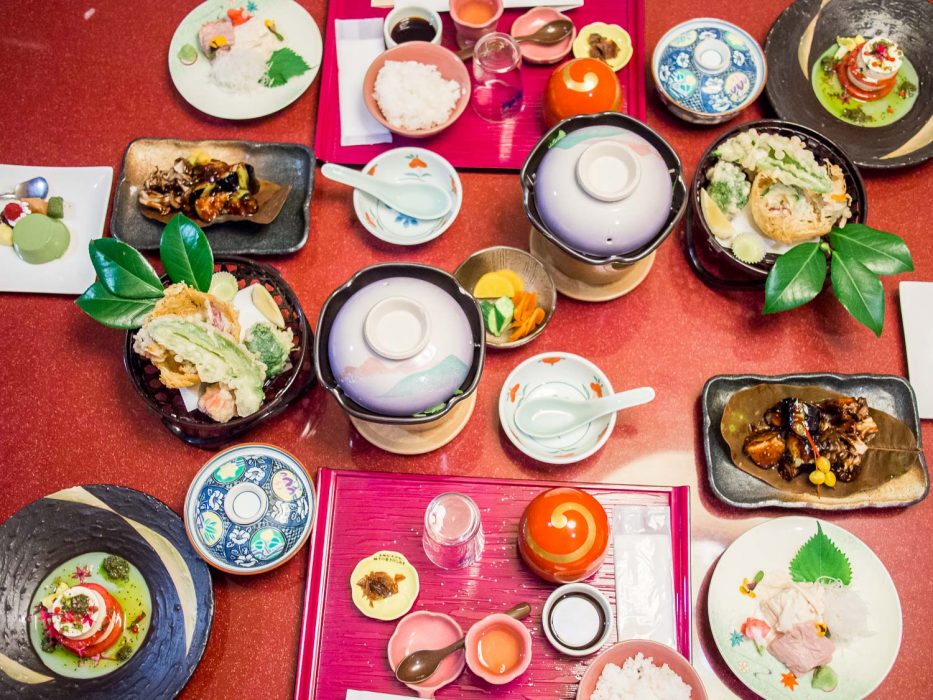
Buy a Japanese Data SIM Card
I highly recommend taking an unlocked phone to Japan, unless you already have a reasonably priced international data roaming plan.
You can then buy a data SIM card when you arrive. On one trip, we bought one from the Umobile vending machine at Tokyo Narita airport.
Even better is to buy an Airalo eSIM in advance. They are even easier as you don’t need a physical SIM card and can set it up before you arrive in the country. We’ve used it on our last Japan trip with no issues.
Being connected will make it easier to find vegetarian restaurants using Google Maps and Happy Cow, and it also allows you to use Google Translate (although you can download the Japanese language to use offline).
Use Google Translate
Packaging in convenience stores is almost entirely written in Japanese so it’s difficult to know the ingredients of a snack or rice ball.
We use Google Translate’s image feature to translate ingredient lists on packaging just by pointing our phone’s camera lens at it and pressing the camera icon in the app.
The instant translate view doesn’t always work, so for a more accurate translation take a photo of the packet and highlight with your finger the text you want to be translated.
This works for restaurant menus too, although we found most places we visited had English menus.
Beware Dashi
It is often possible to find meals without meat or fish in them or at least restaurants may be willing to adapt meals for you, but the biggest problem is that fish stock or dashi is used in many dishes.
Soups, noodles in broth, and dipping sauces in non-vegetarian restaurants will likely contain dashi, and you’ll need to decide whether this bothers you or not.
On our first trip to Japan, we tried to avoid dashi as much as possible, but there were times when we didn’t have much choice so decided to be flexible about it.
On more recent trips we’ve found it easier to avoid dashi. The best way is to eat at a vegetarian restaurant—this is easiest in Kyoto, Tokyo and Osaka where there are lots of options.
We’ve also found that non-vegetarian restaurants are increasingly offering dashi-free options, but you do need to hunt these places out in advance.
Recommended Reading: 18 Best Vegan and Vegetarian Restaurants in Tokyo.
Plan Ahead
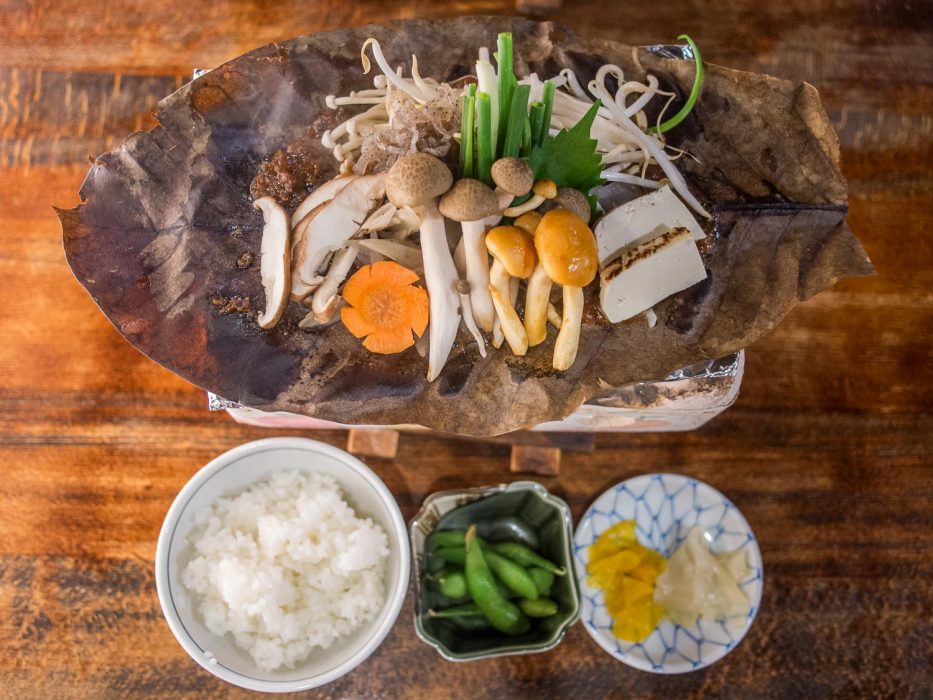
Although you could use the recommended phrase or vegetarian card above and turn up in any Japanese restaurant and hope you get a meal, we found it much more enjoyable to eat stress (and dashi) free at vegetarian restaurants or Japanese places with vegetarian menus.
It’s best to do some research online on sites like Happy Cow and plan ahead where to eat. See the bottom of this post for our favourite vegetarian restaurants in Japan as well as our guide to Kyoto vegetarian restaurants.
If you get stuck, like we sometimes have when the vegetarian restaurant I researched was closed, try looking for Indian or Italian restaurants which always have meat-free options.
Bakeries are also a good place for a snack. The Vie de France chain is found in many train stations and has options like margherita pizza slices, cheese rolls, garlic bread, and pastries.
We’d rather eat a Japanese meal, but when that’s not possible it has stopped us from going hungry.
Recommended Reading: 10 Best Vegan and Vegetarian Restaurants in Osaka.
Visit Kyoto, Tokyo or Osaka
Japan’s three major cities for tourists are the best places to find vegetarian Japanese food and the options are growing all the time. See our recommended restaurants in each of these cities below.
They all have lots of entirely vegetarian or vegan restaurants. We especially love the healthy and affordable set lunches that most of these places offer featuring rice, miso soup, pickles, and an array of tofu and vegetable dishes.
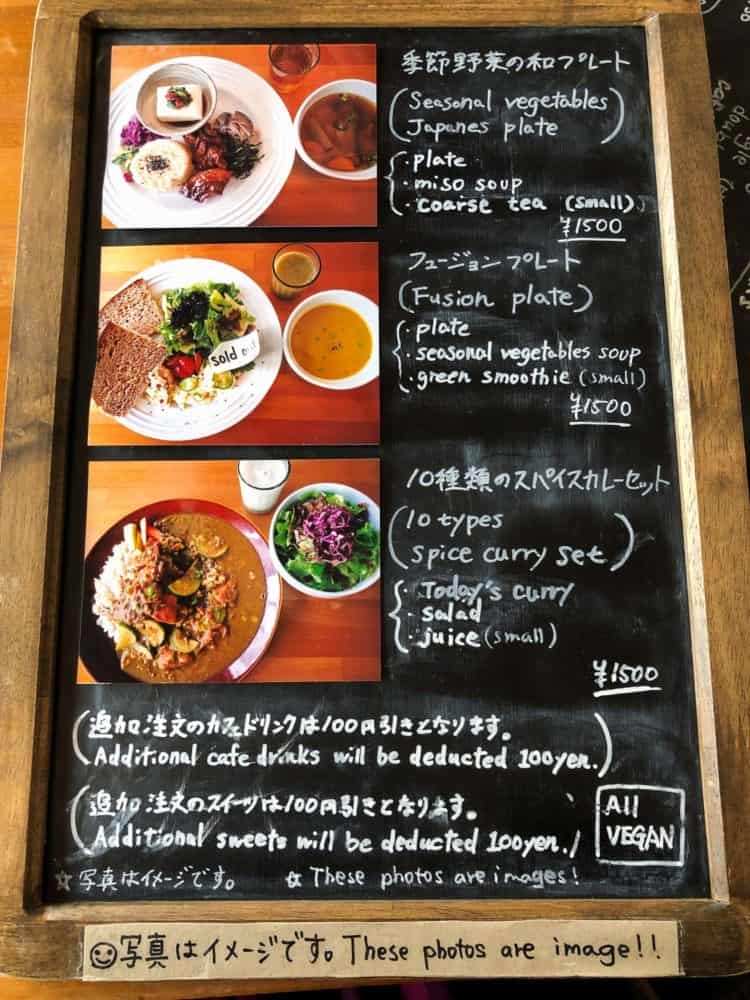
Vegetarian set lunches are a great way to explore Japanese food as you don’t have to worry about being able to read a Japanese menu and you can be sure that everything is meat-free.
Kyoto is especially worth visiting, as Japan’s ancient capital has a long tradition of shojin ryori or Zen Buddhist temple cuisine, which is entirely vegan.
That’s not to say you should only visit the big cities. There are many amazing places to visit in Japan and you can find vegetarian options in smaller towns. It’s just nice to be able to sample the wider array of veggie-friendly restaurants in the cities for at least part of your trip.
Travel Tip: Consider buying a Japan Rail Pass in advance before arriving in Japan. It may save you money and it makes travelling around the country much easier. See our Japan Rail Pass guide to figure out if it’s worth it for your trip.
Eat Shojin Ryori in Temples
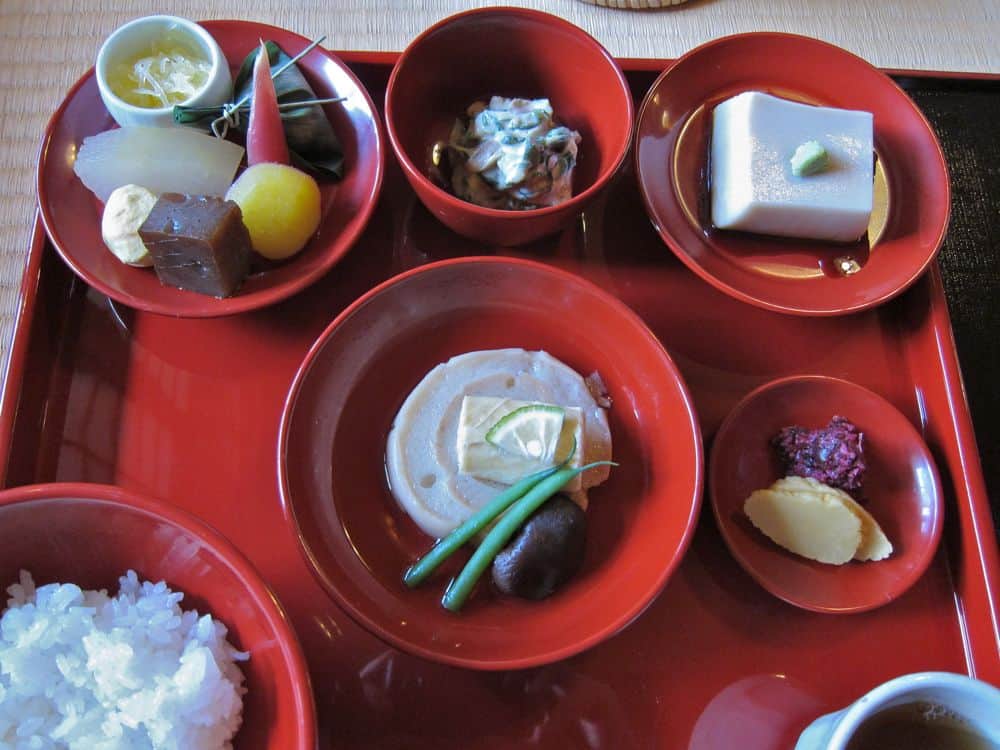
Shojin ryori or Zen Buddhist temple cuisine is the beacon of hope for a vegetarian in Japan. The monks make it possible to enjoy delicious, healthy, creative Japanese meals and be sure that it is all vegan.
These multi-dish meals are beautifully presented and use seasonal ingredients. They usually include various types of tofu, an array of vegetables, rice, pickles, miso soup, and more unusual items such as the jelly-like konnyaku (made from the konjac plant).
The best places to eat shojin ryori are in temples in Kyoto such as Shigetsu in Tenryuji and in the mountain town Koya-san where you can even spend the night in a temple.
It’s not just limited to temples, though, as we saw shojin ryori offered in traditional restaurants in many places around Japan including Nikko, Takayama, and Kanazawa.
We had a fantastic fucha ryori meal, which is a version of shojin ryori with a focus on tea, at Bon in Tokyo.
Although it can be expensive—our lunch at Bon was 5000 yen ($32) each—it’s worth splurging on shojin ryori at least once as it’s an experience as much as a meal. Lunch is usually much cheaper than dinner.
Stay in a Ryokan
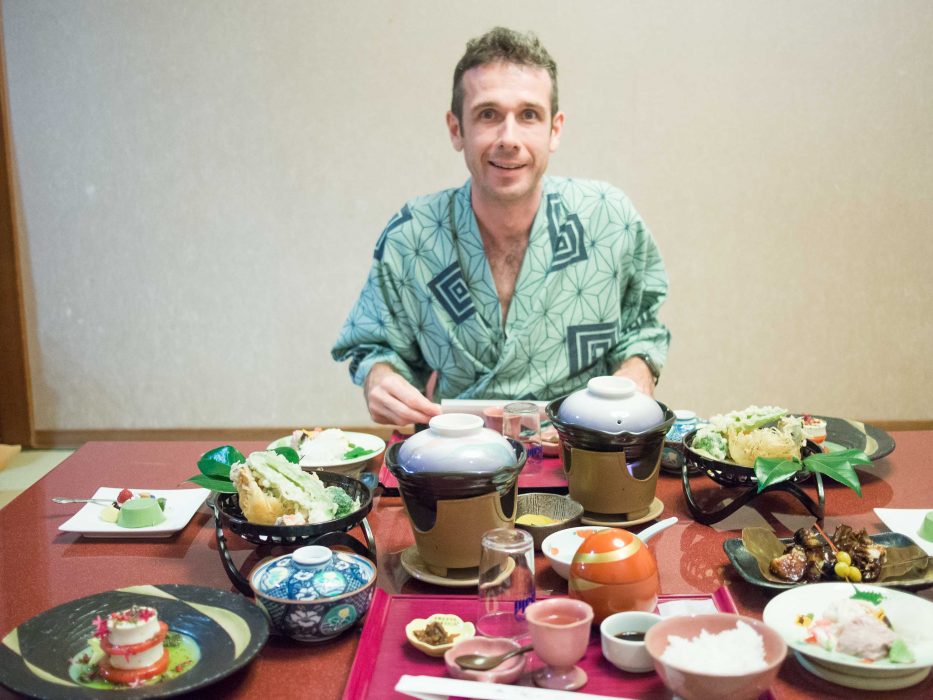
A great opportunity to try homemade kaiseki, a gourmet, multi-course traditional Japanese meal, is in a ryokan or traditional inn.
Meals are usually served in your room and they are some of the best meals we’ve had in Japan.
Not all ryokans cater for vegetarians, so check with them before you book or see if the reviews mention vegetarian meals. Make sure you specify no dashi.
We use Booking.com to find ryokans in Japan—tick the Ryokan button in Property Type in the filter list to find them.
We used it to book our stay at these ryokans, all of which served us incredible vegetarian feasts. Just be sure to tell them your dietary requirements before you arrive.
- Morizuya Ryokan in Kinosaki Onsen – In this small town a few hours from Kyoto or Osaka, you can hop between the town’s seven onsen (hot spring baths) in a kimono. We had several delicious meals in our room here.
- Tsukihitei in Nara – This traditional inn has a magical forest setting. Our delicious 9-course dinner was served in a private room next to our bedroom.
- Iwaso on Miyajima Island – Wonderful meals are served in the dining room at this beautiful ryokan.
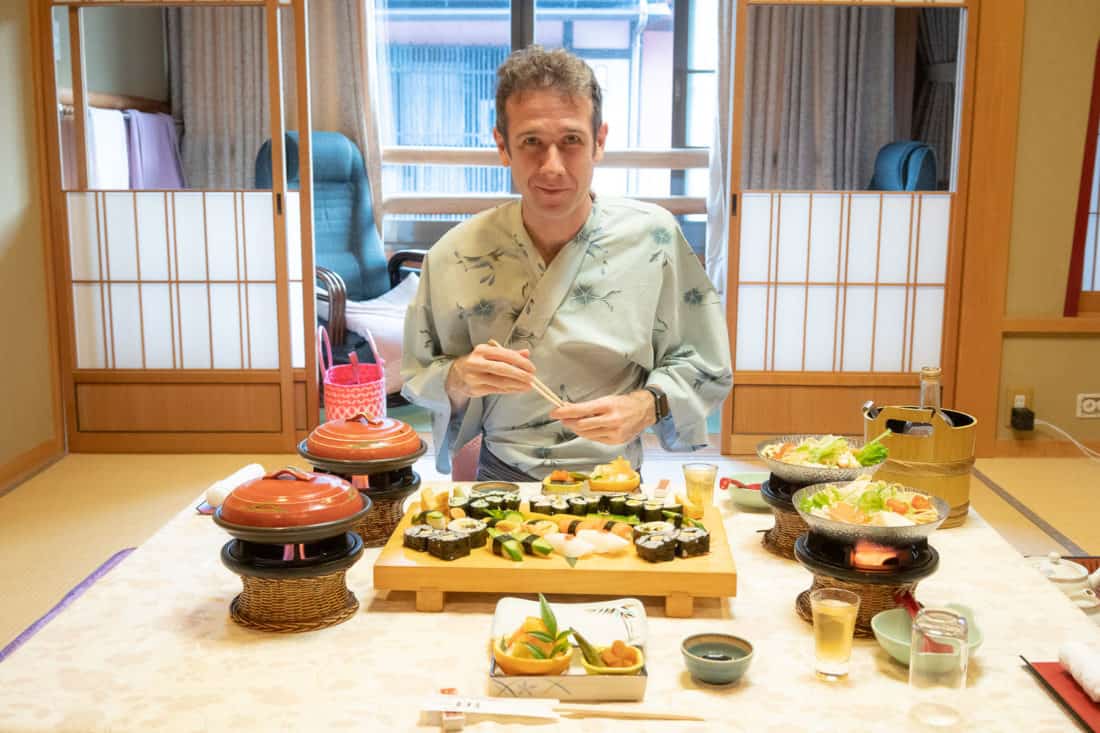
Staying in a ryokan is pricey, but it’s a unique experience and one of our favourite things to do in Japan.
Read our comparison of different accommodation in Japan for more details.
Self-Cater
We usually stay in a self-catering apartment for at least part of our trips to Japan. Self-catering helps save money and we get a break from worrying about where to eat.
We found the array of fresh noodles and tofu in supermarkets to be delicious and reasonably priced. Add some vegetables and you can make an easy stir-fry.
We’re also a fan of T’s Tantan instant ramen pots when we’re in Tokyo for a quick meal. You can buy them from the restaurant (one of the best places for vegan ramen in Tokyo) or from Natural Lawsons convenience stores.
The CoCo Ichibanya curry chain also sells a takeaway vegetarian curry pack that you just heat up.
The best places to stay in apartments are the bigger cities like Tokyo, Kyoto and Osaka where there are plenty of options.
Search on Vrbo for apartments in Japan here.
Take a Cooking Class
Taking a vegetarian cooking class in Japan is an excellent way to learn more about Japanese cuisine, make sense of the confusing ingredients, and learn what you can and can’t eat as a vegetarian.
Plus they are a lot of fun and you’ll get to enjoy a delicious meal.
The cooking class we did in Kyoto is no longer available, but this Afternoon Izakaya Cooking Class in Kyoto can cater for vegetarians.
In Osaka, this private Japanese In-Home Cooking Lesson and Meal offers vegetarian and vegan options on request.
Vegetarian Japanese Food
These are some vegetarian Japanese meals and snacks to look out for.
Be aware that anything that includes broth is likely to be fish dashi unless you are eating in a vegetarian restaurant or the menu says it doesn’t use dashi.
Tempura
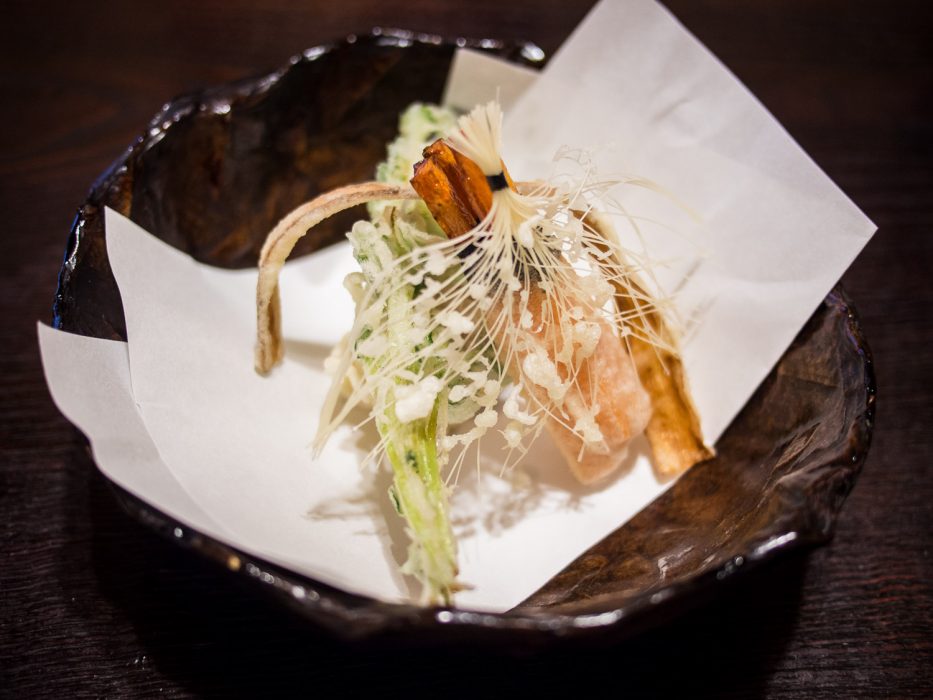
Tempura, deep fried vegetables in batter, is the easiest vegetarian Japanese food to find. Most tempura restaurants have a vegetable option or you can ask for vegetables only.
We had tempura donburi, tempura on top of rice, at Tendon Tenya, an inexpensive tempura chain. We skipped the included miso soup as it contains dashi.
For a more upmarket but still reasonably priced tempura meal, we enjoyed Tsunahachi in Shinjuku, Tokyo where we had a vegetable only version of their lunch set. They also have branches in Kyoto and Hokkaido.
Fuji Tempura Idaten in Kawaguchiko (near Mount Fuji) was another good spot with a vegetable-only tempura option.
Tsukemono
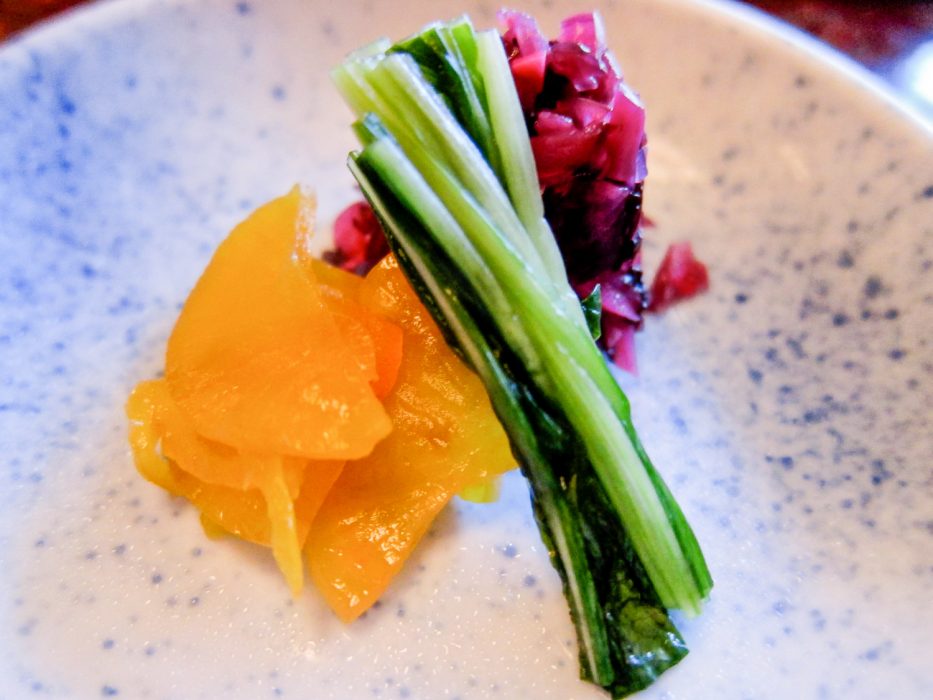
Tsukemono or Japanese pickled vegetables are an essential part of a Japanese meal and are always included in set meals.
I love the crunchy texture and salty, sweet and sour flavour that provides a contrast to the more delicately flavoured dishes. In a worst-case scenario, you could always order tsukemono and rice for a simple meal.
Zaru Soba
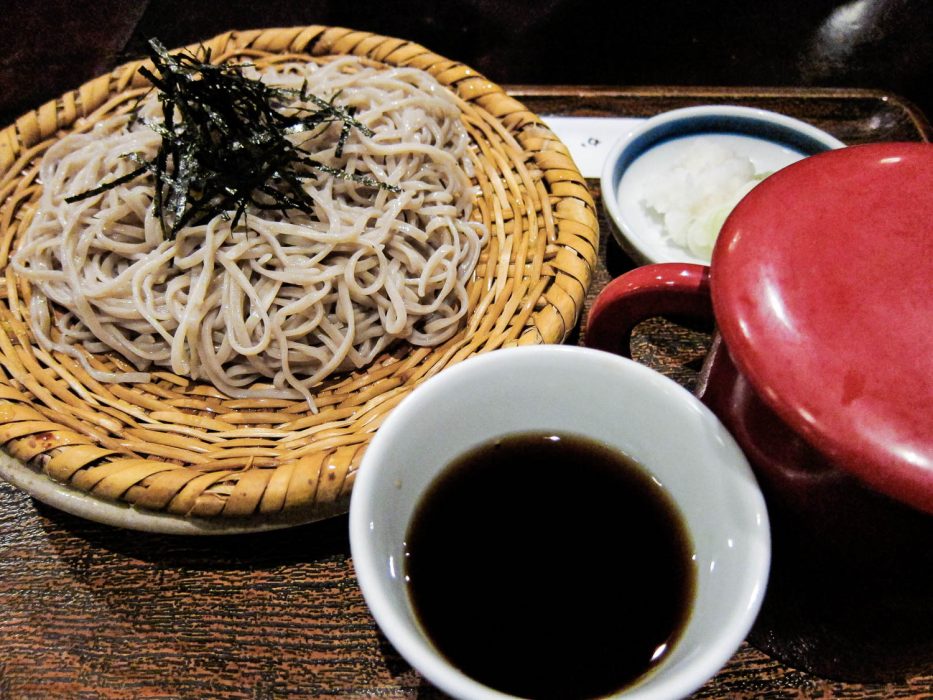
Cold soba (buckwheat) noodles are popular in the summer served on a bamboo tray with nori seaweed, spring onion, wasabi, and a soy sauce dipping sauce that we skipped as it has dashi in it. If this doesn’t worry you then go ahead and dip the noodles in.
Soba or Udon Noodles
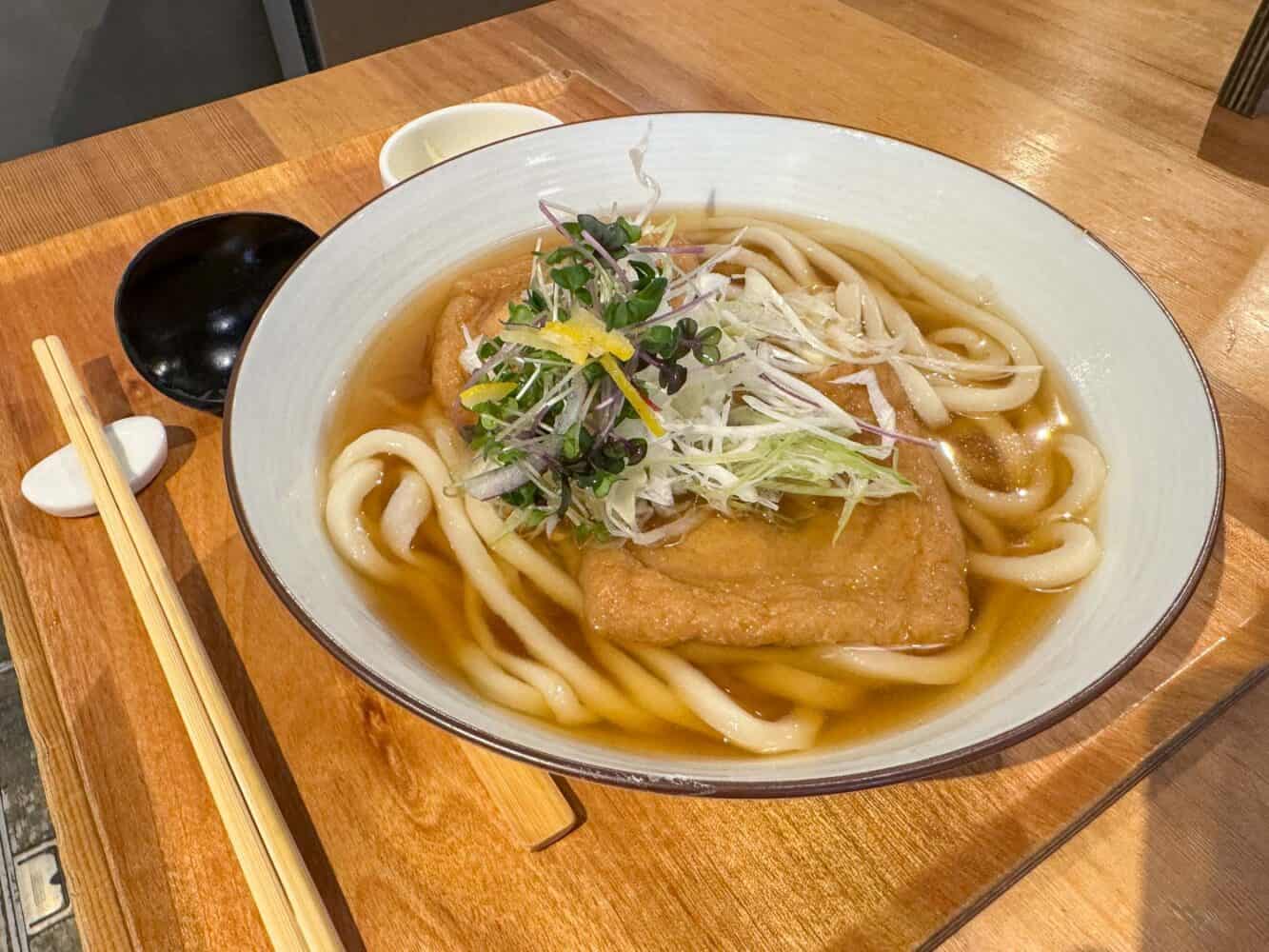
Noodles in broth are found everywhere and are made from soba (buckwheat) or udon (wheat) with a range of fillings.
If you explain you don’t eat meat or fish, you should be able to get a vegetable-only version, although the stock will likely be fish based.
To avoid this order zaru soba (above), cold noodles that don’t come in broth. Udon restaurants may also have a cold broth-free version.
Thankfully, there are more and more noodle shops offering vegan broth. Here are some we’ve tried:
- In Kyoto, we love the curry udon at Mimikou.
- In Nara, Mizuya-chaya can make a few of their udon dishes vegan. The broth is quite plain but you can add spicy seasoning. It’s convenient when sightseeing as it’s close to the temples.
- Taiko Udon in Hiroshima has a whole vegan section of their menu. Again, it was pretty simple but we were glad to find a meal in the area.
Ramen
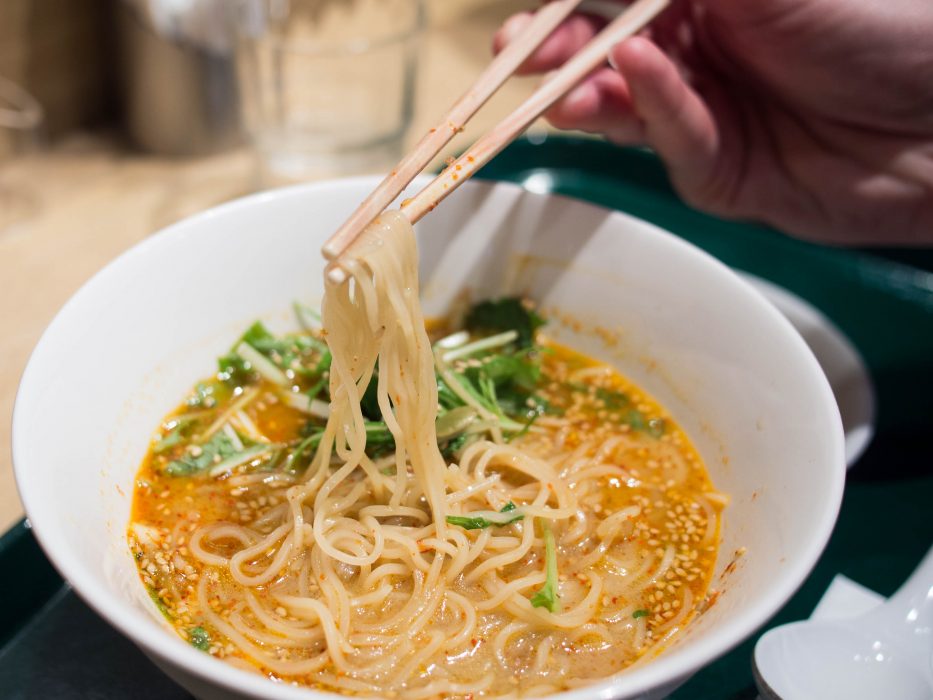
An increasing number of ramen shops in Japan now offer vegan ramen, so you can enjoy this classic noodle soup without meat.
Our favourite ramen is at artsy Vegan Ramen Uzu in Kyoto. It’s not the cheapest, but it’s full of flavour and uses high quality ingredients.
A convenient place to try ramen is T’s Tantan, an entirely vegan ramen shop in Tokyo Station with tons of options as well as instant ramen to take away (you can also buy it at Natural Lawson convenience stores in Tokyo).
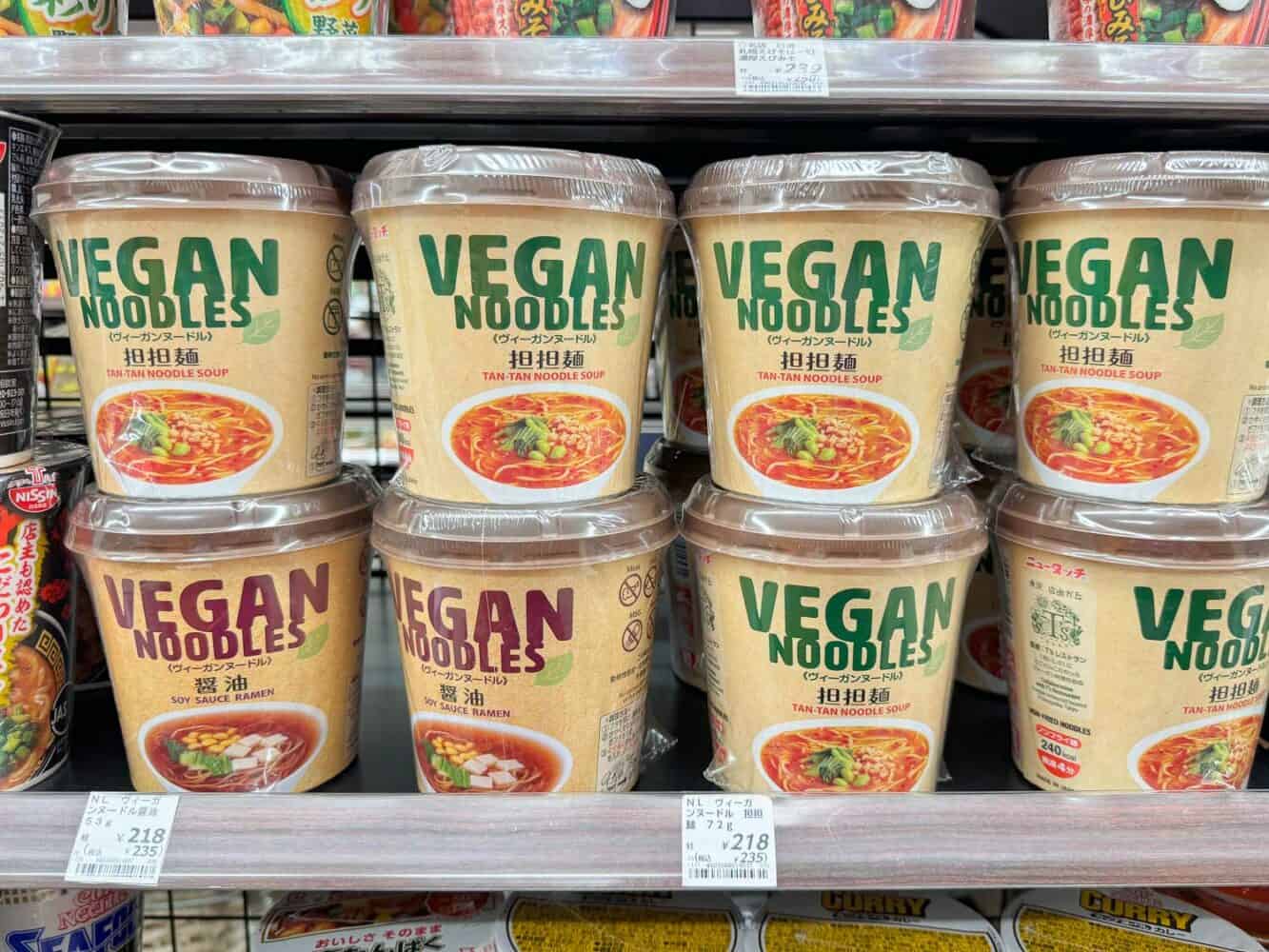
Ramen chains that have vegan ramen include Kyushu Jangara Ramen and Afuri.
Our restaurant guides to Tokyo, Kyoto and Osaka list more ramen options.
Miso Soup
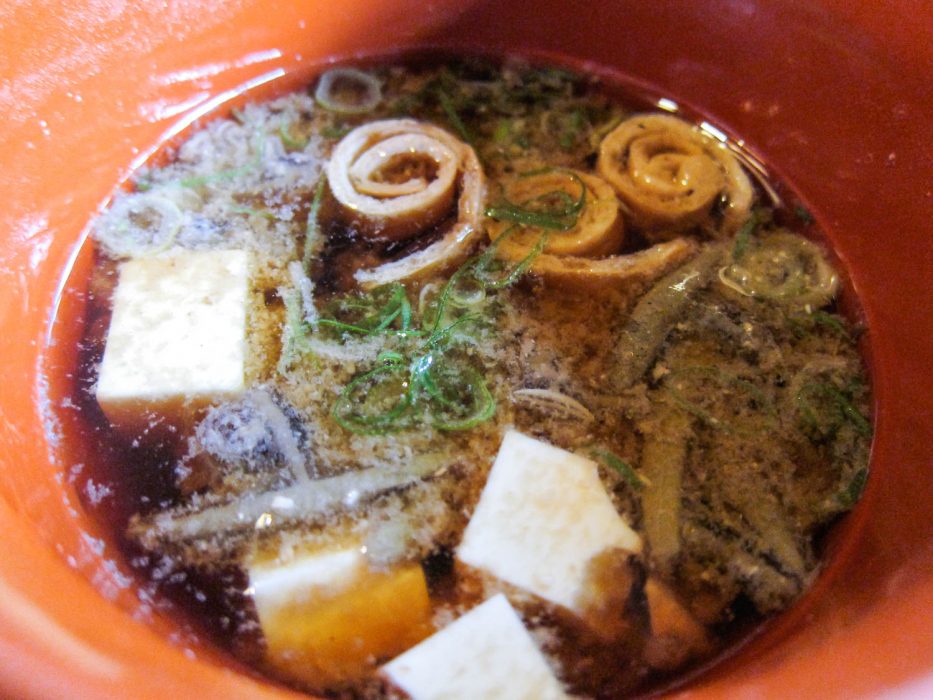
Miso soup (often with tofu and green onions) is part of every set meal including breakfast. Chopsticks are used to eat the ingredients and the broth is sipped directly from the bowl.
We only eat miso soup in vegetarian and vegan restaurants where we know they haven’t used dashi.
Okonomiyaki
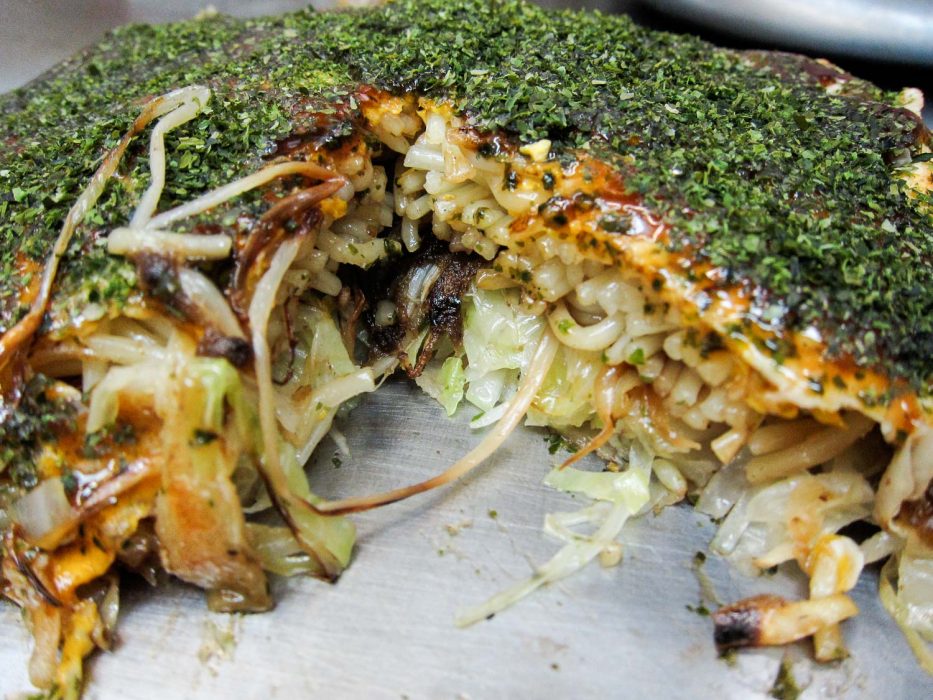
Okonomiyaki is a type of Japanese savoury pancake made with a base of egg and milk batter and shredded cabbage plus other ingredients.
Although it usually isn’t vegetarian, it can be adapted to be by using vegetable fillings. You can also occasionally find places offering vegan versions.
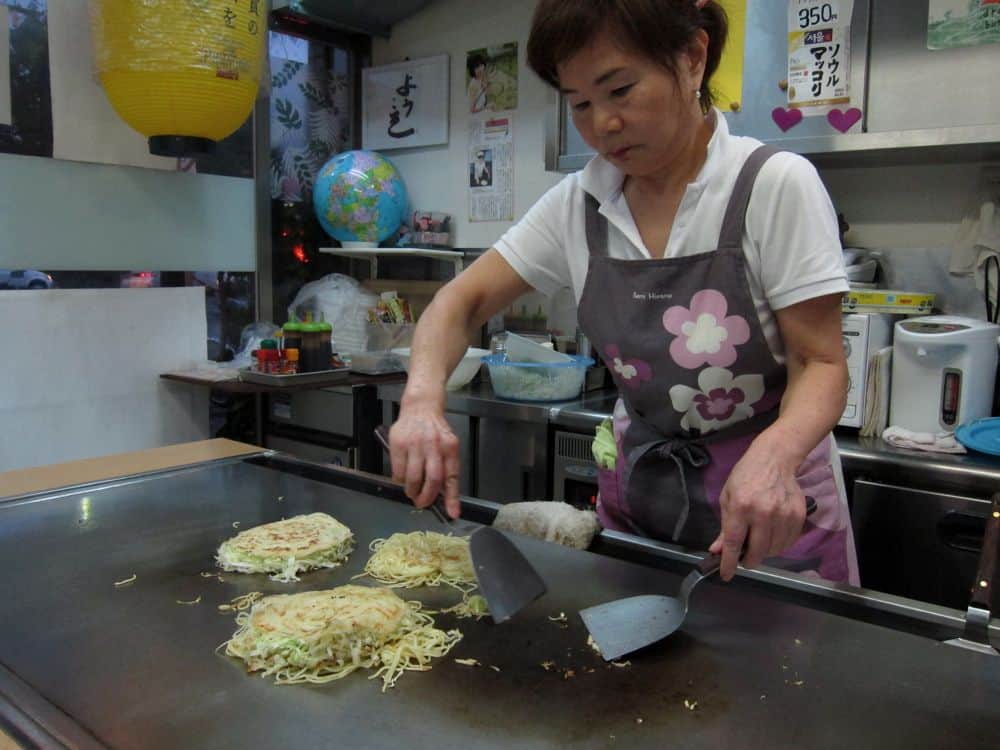
In Tokyo, we love the tomato and cheese okonomiyaki at Zen in Shinjuku. They have a vegetarian section of their English menu that explains the ingredients of the different types of okonomiyaki and we got ours without dashi by showing our vegetarian card.
In Osaka, Okonomiyaki Chitose offers vegetarian and vegan versions.
In Kyoto, Kamehameha has vegan okonomiyaki plus some appetisers (we got the vegan set). Make sure to book a table at this tiny place.
Japanese Curry
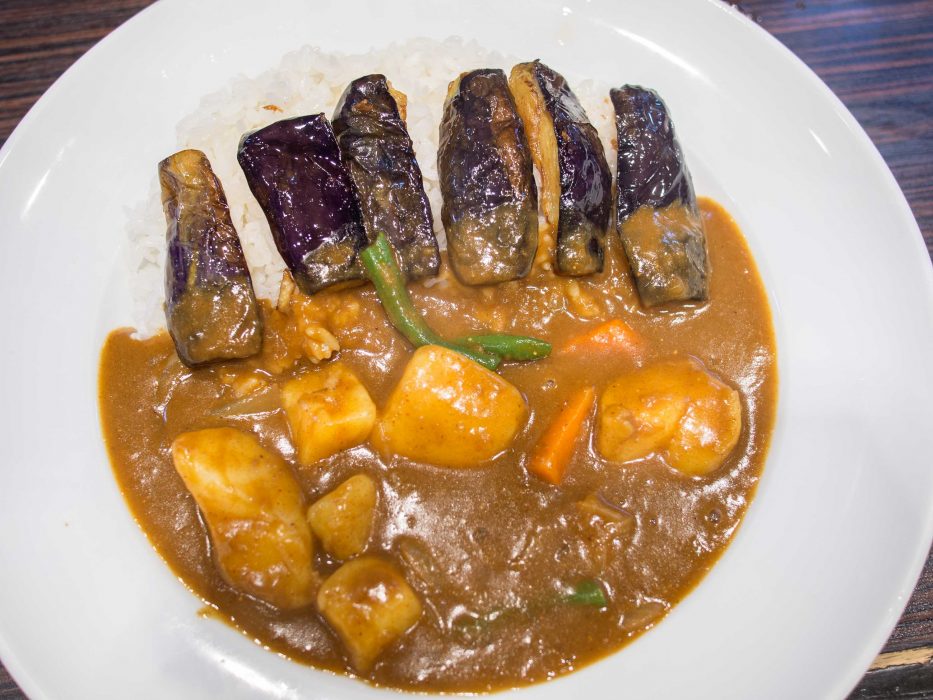
Curry is really popular in Japan. It’s different from the Indian version but still tasty. Many Japanese curry places will offer a vegetable curry, but it’s likely the roux was made with meat.
For an entirely vegan curry, head to CoCo Ichibanya, Japan’s largest curry chain, which now has a meat-free curry in all its stores. It’s described as vegetarian but is vegan.
They have an English menu and you can customise your order. You choose your curry sauce (vegetarian), toppings (we usually get vegetables and eggplant), spice level (2 or 3 is pretty spicy), and size of rice portion.
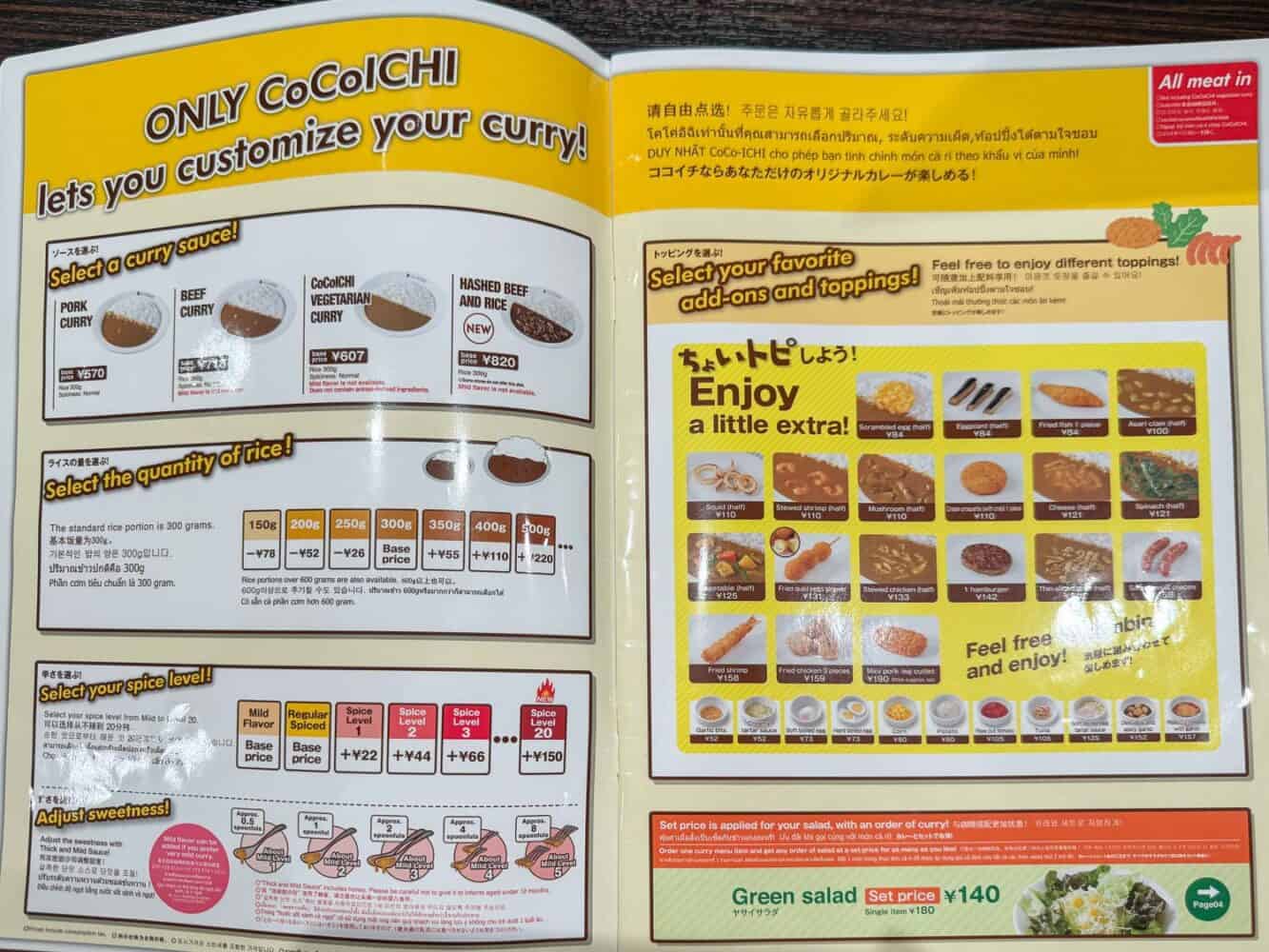
The pickles on the table are vegan.
If you are self-catering, they also have takeaway vegetarian curry packs, which you can heat up at home.
To find your nearest branch of CoCo Ichibanya, just search on Google Maps. It’s especially useful in less touristy cities where Japanese vegetarian food is harder to find. It’s a cheap, tasty, and quick meal.
You can also find vegan Japanese curry in many vegan restaurants.
Sushi
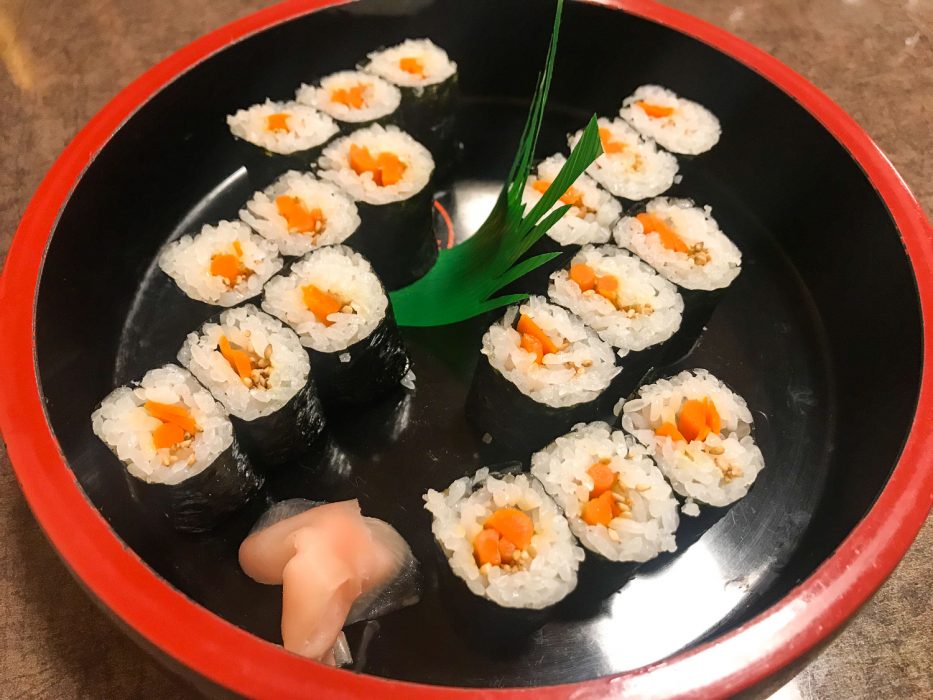
Vegetarian sushi is not easy to find in Japan, but it is possible.
Look out for kappa-maki (seaweed rolls with cucumber) and takuan-maki (pickled daikon radish roll). You can also find sushi rolls made with umeboshi (pickled plum), natto (fermented soybean), and egg.
Inarizushi is rice stuffed in a tofu pocket—just check it wasn’t made with dashi.
We have enjoyed vegetarian sushi at:
- Komekichi Kozushi in Nikko.
- Little Heaven, Uzu and AWOMB in Kyoto.
- Morizuya Ryokan in Kinosaki Onsen (you don’t get a choice of menu though).
- Sushi Gonpachi Shibuya in Tokyo.
Gyoza
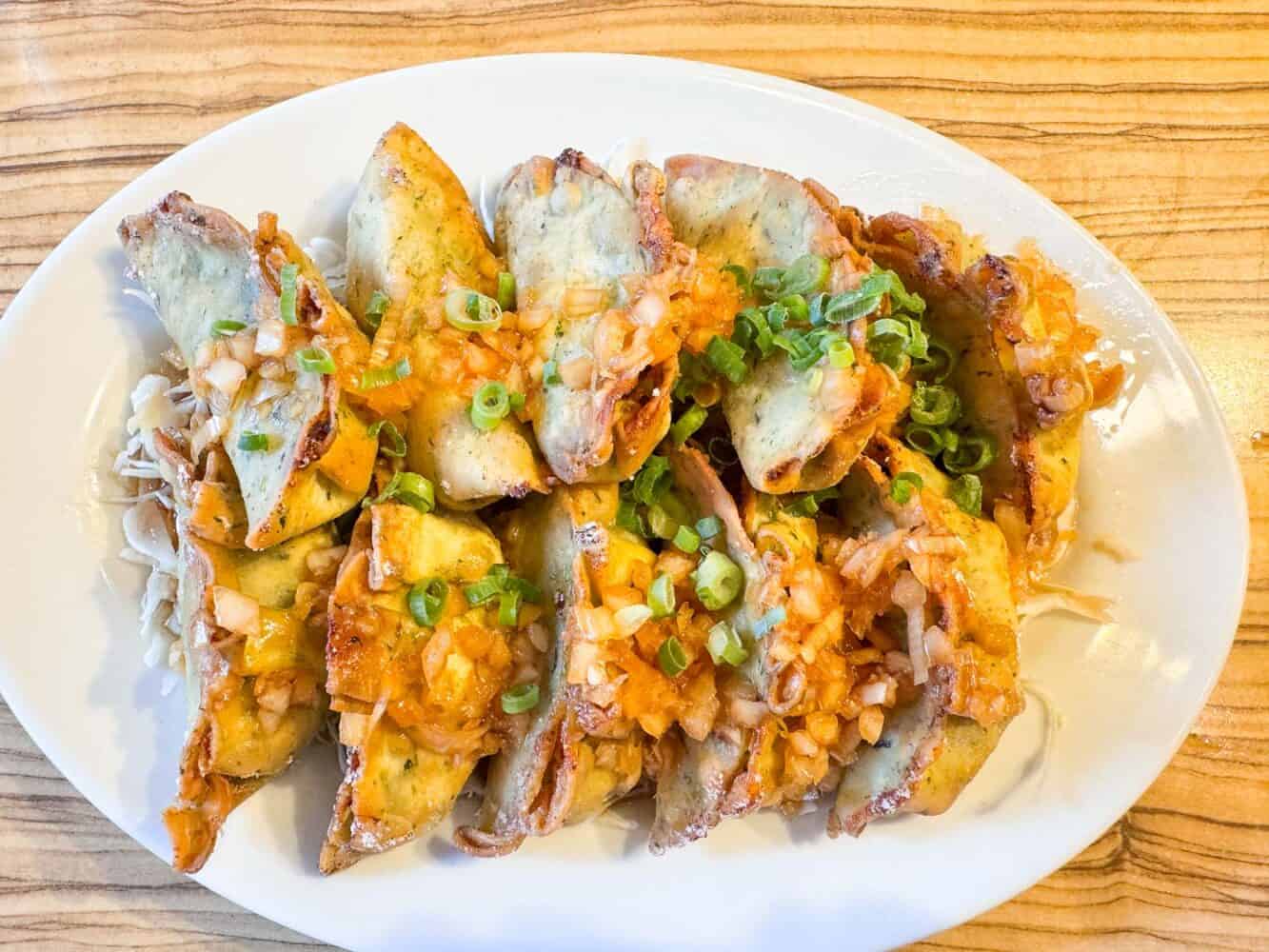
Gyoza (dumplings) are another typical Japanese dish that are becoming easier to find in vegan versions.
You can enjoy a plate of them (perhaps with a few sides) in a dedicated gyoza shop or izakaya (pub). Or it’s common to get a few as a side in a ramen shop.
They come with a variety of fillings such as mixed vegetables, soy meat, or mushroom. You can often choose from steamed or fried.
Some good places to try gyoza are:
- Vegan Bistro Jangara in Tokyo – My favourite gyoza. You can get a few as a side for ramen.
- Izakaya Masaka in Tokyo – An all-vegan pub with lots of small plates like gyoza.
- Kakekomi Gyoza in Tokyo – A lively gyoza shop with a few vegan options.
- Gyoza Chao Chao in Kyoto – A fun place with vegetarian and vegan gyoza but queues are long.
Nasu Dengaku
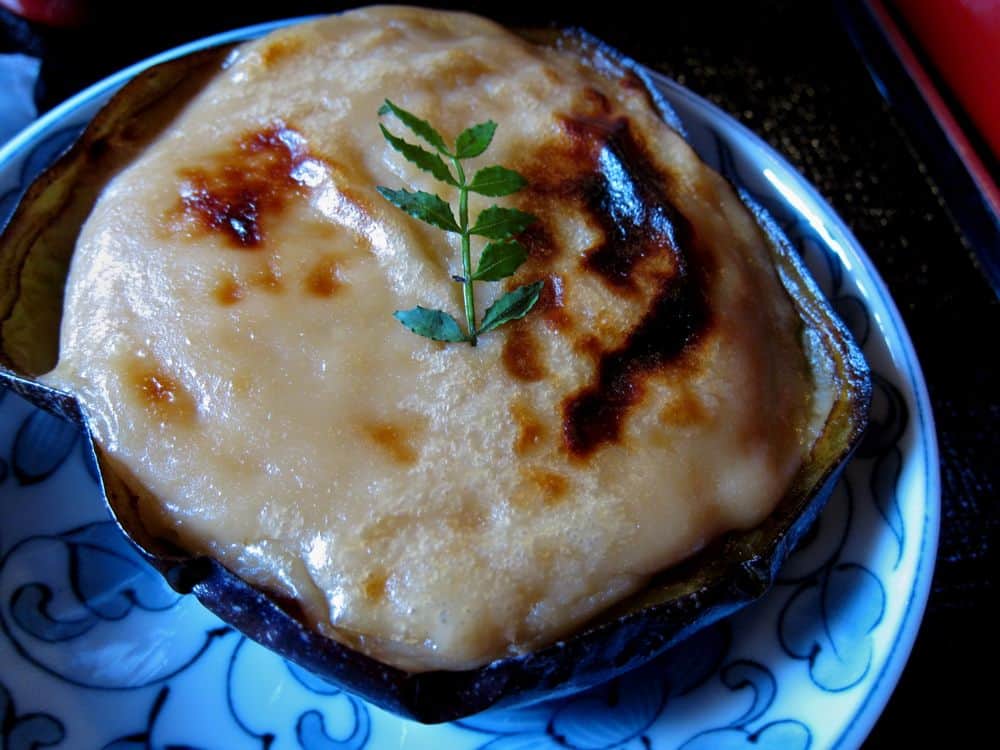
Eggplant is grilled until soft and melty with a sweet caramelised miso topping. Nasu dengaku is a delicious comfort food that we ate at Shigetsu temple restaurant in Kyoto.
Gohei Mochi
Gohei mochi is a speciality of the Kiso Valley area that we sampled in the small, traditional village Tsumago.
They are delicious grilled rice dumplings served on a stick in a sesame and walnut sauce. Don’t miss them if you are in the area.
Dango

Another variation of the rice ball on a stick street food is dango, which we tried in Nikko and Takayama. The dumplings are smaller and are brushed with miso or soy sauce.
Yaki Onigiri
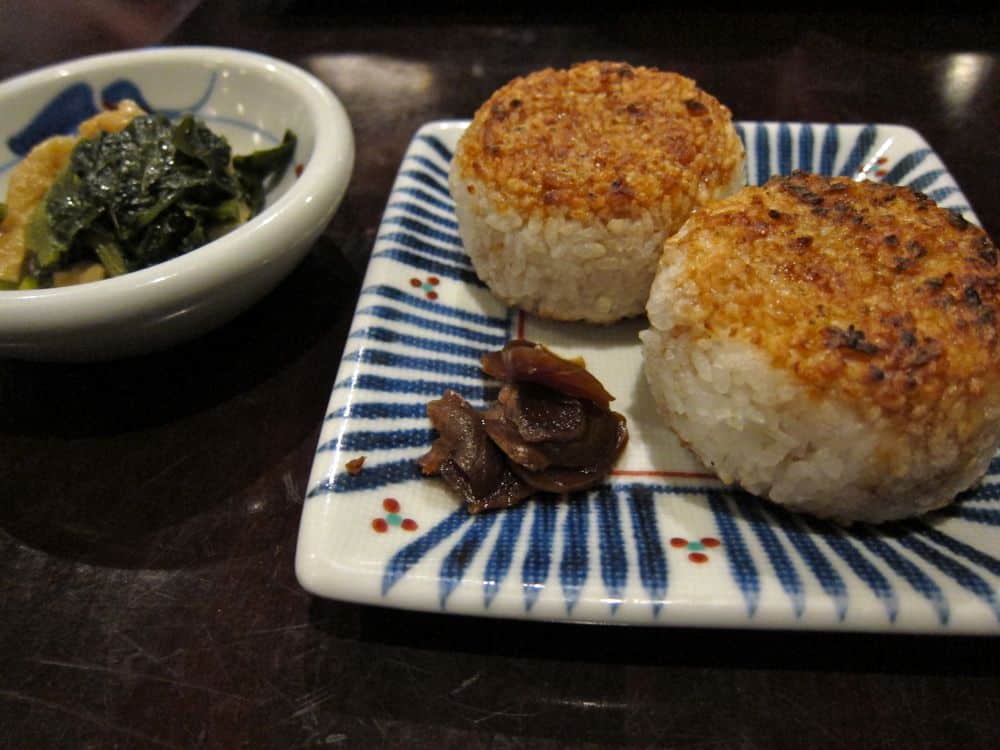
Grilled rice balls in a soy sauce glaze are served with tofu, cold greens, and pickles on the side. They are quite plain but still a good vegetarian option. We ate yaki onigiri at an izakaya (Japanese pub).
Umeboshi Onigiri
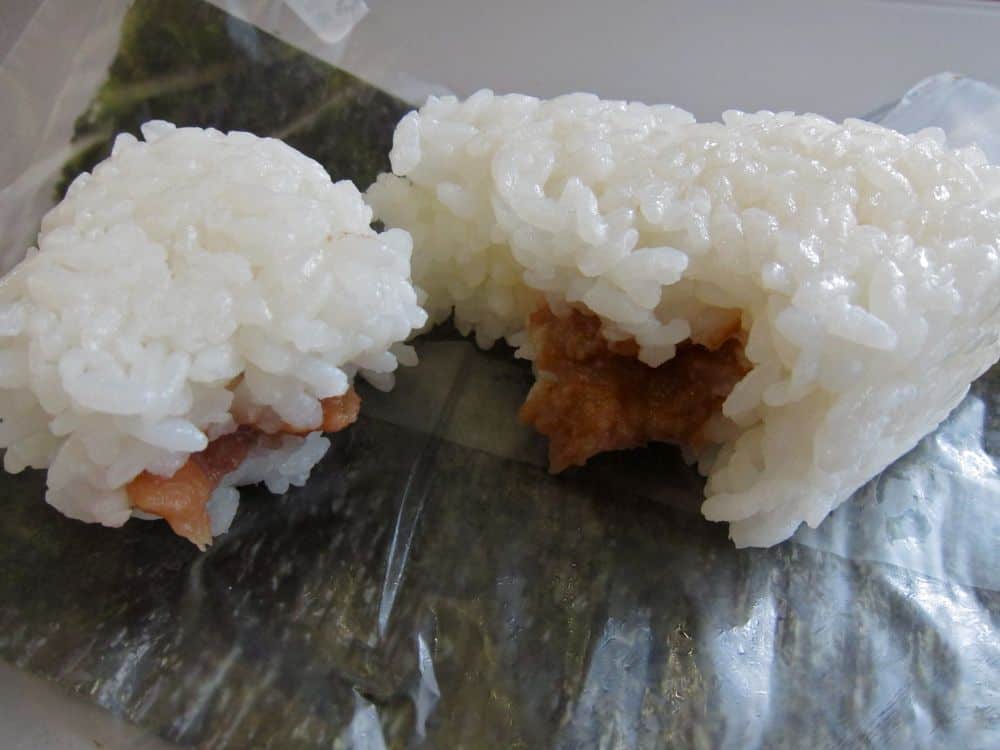
Onigiri (rice balls) are found at every convenience store and supermarket and make good cheap packed lunches.
The problem is the labels are usually in Japanese, so it is difficult to see which ones are vegetarian. Family Mart and 7-Eleven now have the names in English, which makes things much easier.
Plain and umeboshi (pickled plum) are the most common vegetarian onigiri. Umeboshi packaging is usually pink and plain ones are clear. You could also use Google Translate (see above).
I have also asked a nearby stranger in pigeon Japanese “Dore umeboshi des ka?” (which one is pickled plum?) and she pointed out the right one.
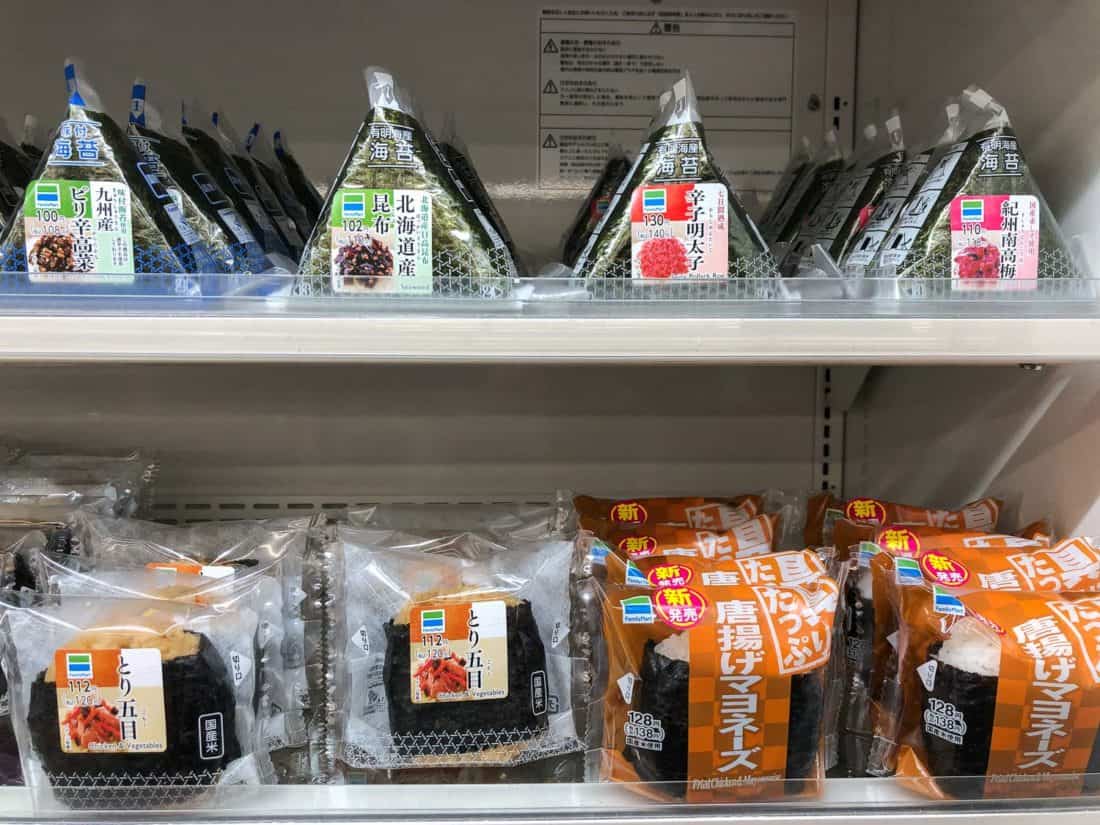
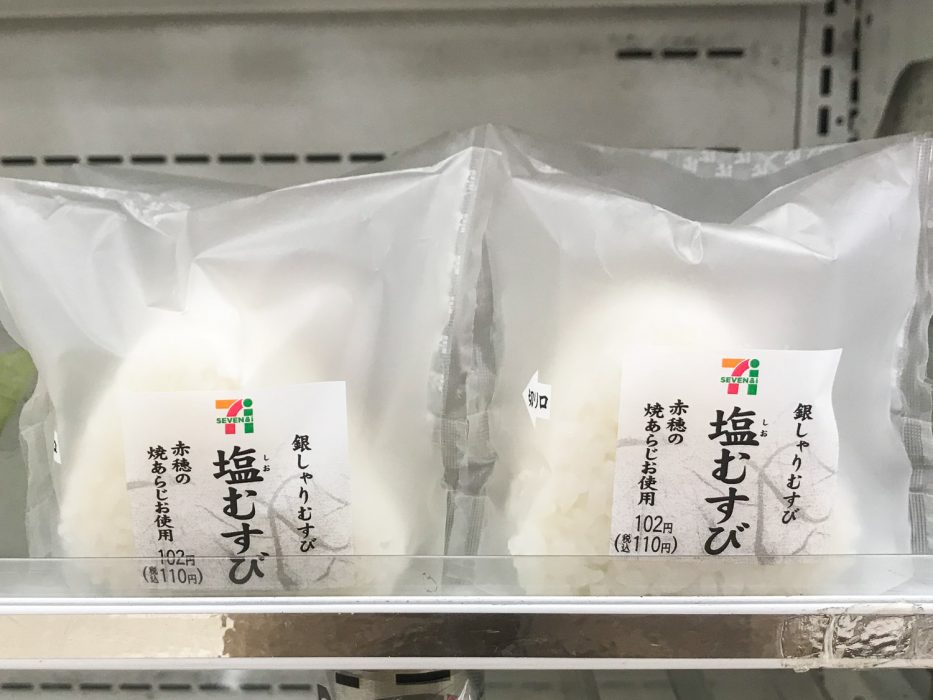
Sekihan Onigiri
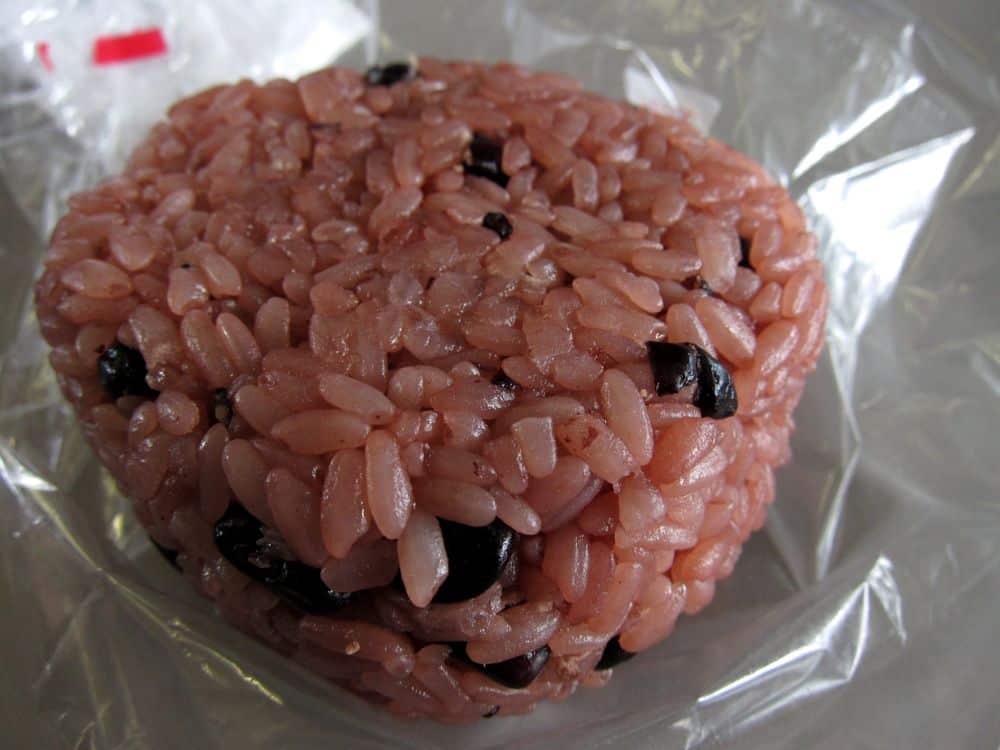
Red rice and adzuki bean balls are another tasty packed lunch you can pick up from a convenience store. The packaging is clear so it’s easy to identify without reading Japanese.
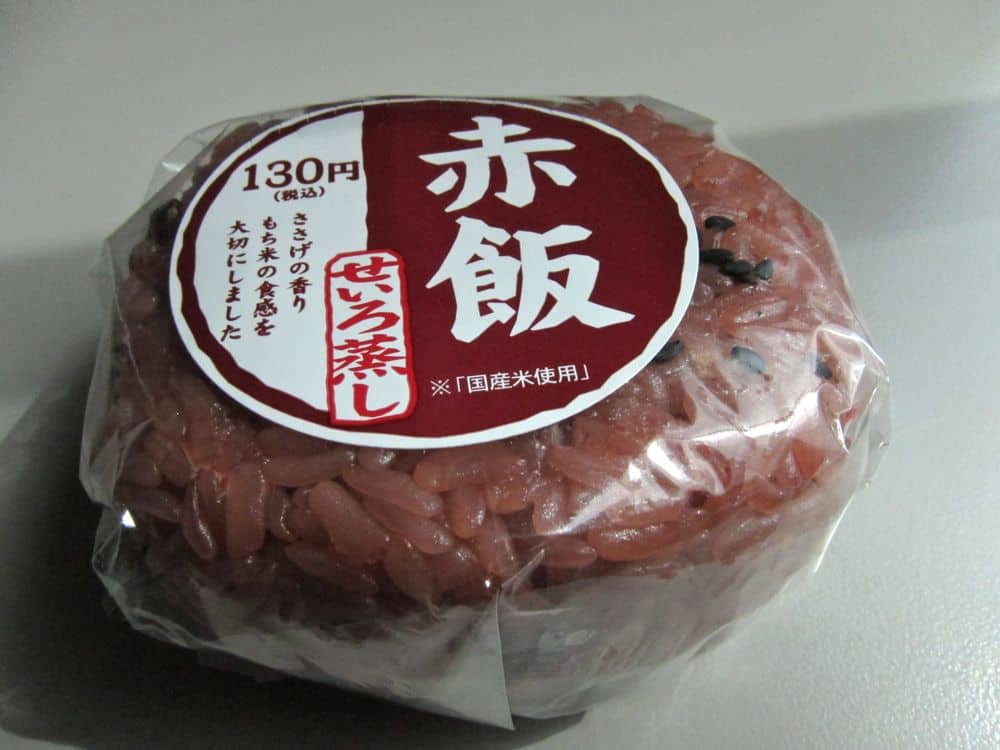
Other Convenience Store Snacks
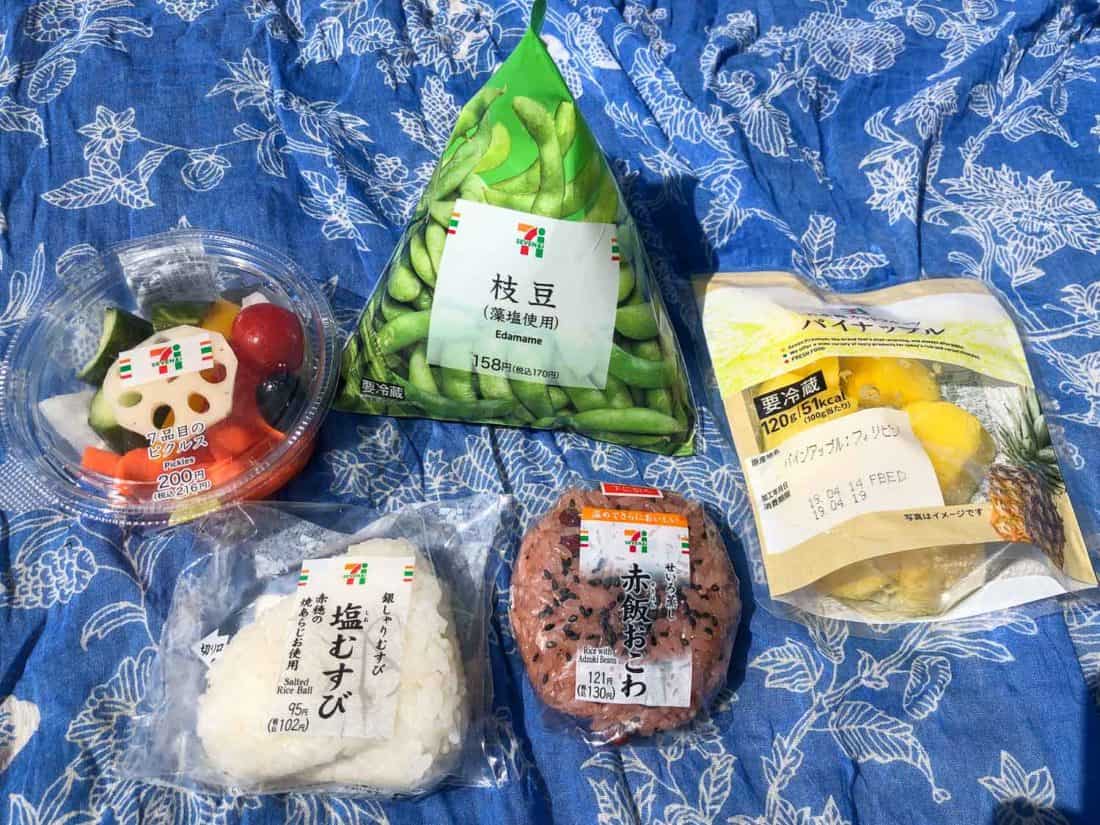
Convenience stores in Japan are amazing and perfect for stocking up on snacks for a picnic or train trip (sadly bento boxes in train stations are not going to be vegetarian).
As well as onigiri, you can find inarizushi (sushi rice in a tofu pocket), edamame beans, pickled vegetables, boiled eggs, french fries (which were not as bad as you’d think), fruit including bananas and cut pineapple, salads (but be careful of the ingredients and dressing), plain cooked noodles, and lots of rice crackers and crisps.
7-Eleven, Lawsons, and Family Mart are the most common convenience stores and you’ll find one on every block in cities.
Family Mart and 7-Eleven now have English labels on their salty snacks, so it’s easier to find plain crisps and avoid the many shrimpy things.
We were tempted by the tubs of spicy cucumber at 7-Eleven, but unfortunately they contain fish sauce.
In Natural Lawson, the healthier version of Lawsons, you might have more luck finding vegetarian-friendly snacks. They also stock the vegan T’s Tantan instant ramen. They aren’t as common as the other stores, though, and are mostly found in Tokyo.
Oyaki
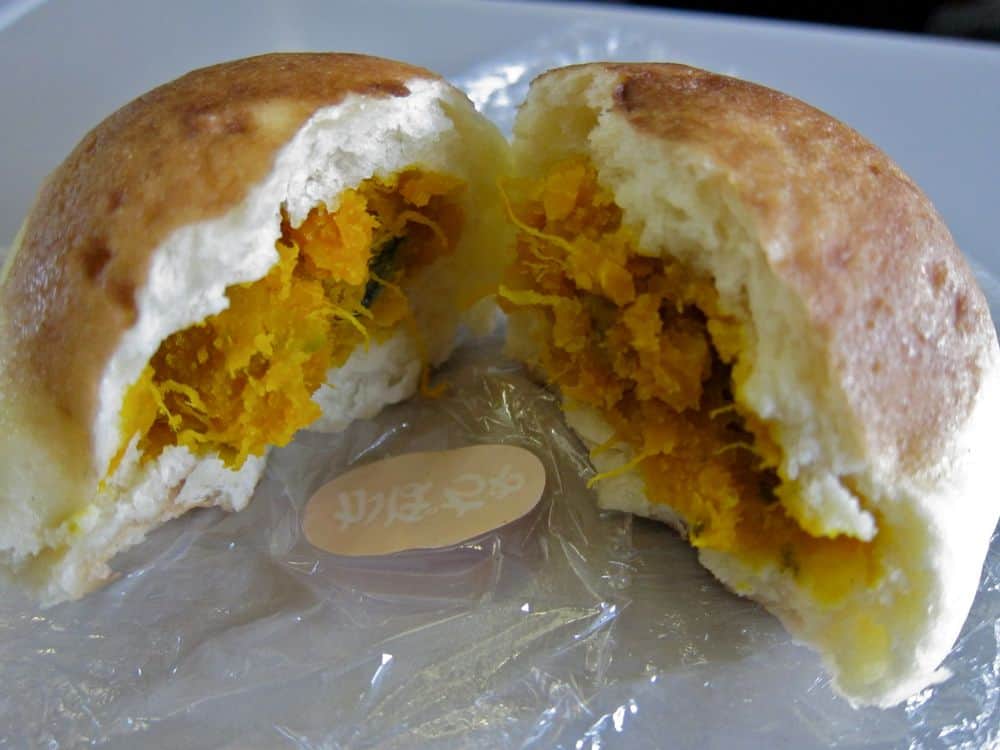
Oyaki is a speciality of the Nagano prefecture and we tried it in Matsumoto. Wheat buns are filled with different vegetables—we tried pumpkin (kabocha).
Kabocha Korroke
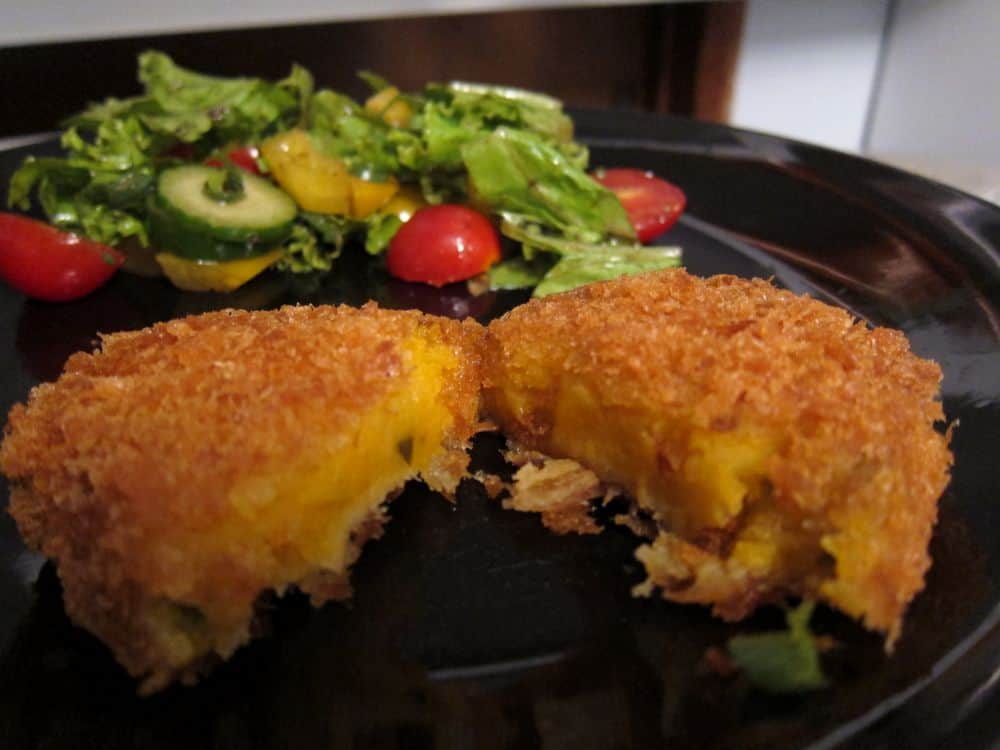
Pumpkin croquettes can be found in the deli section of supermarkets and some restaurants and make a delicious, cheap vegetarian meal. We heated ours up at home and served with a salad.
Be careful of croquettes though—Simon bought a potato croquette from a stand and it turned out to have chunks of meat in it.
Naigamo Yam
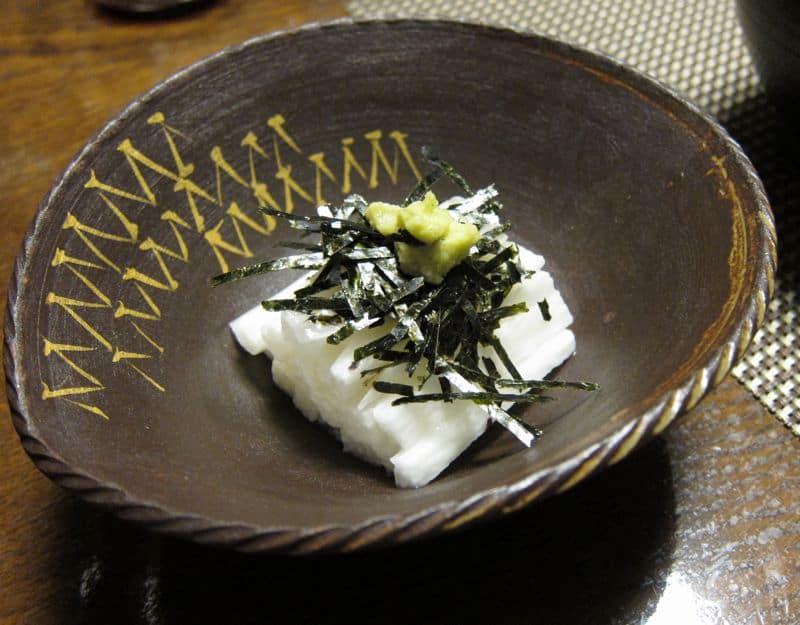
This raw salad dish turned up in a few of our meals. Naigamo yam is rather unusual and wasn’t like the dense, heavy yam that we are familiar with but instead was light, crunchy, sticky, and watery.
The main flavour came from the salty nori seaweed and hot wasabi that it was served with.
Konnyaku
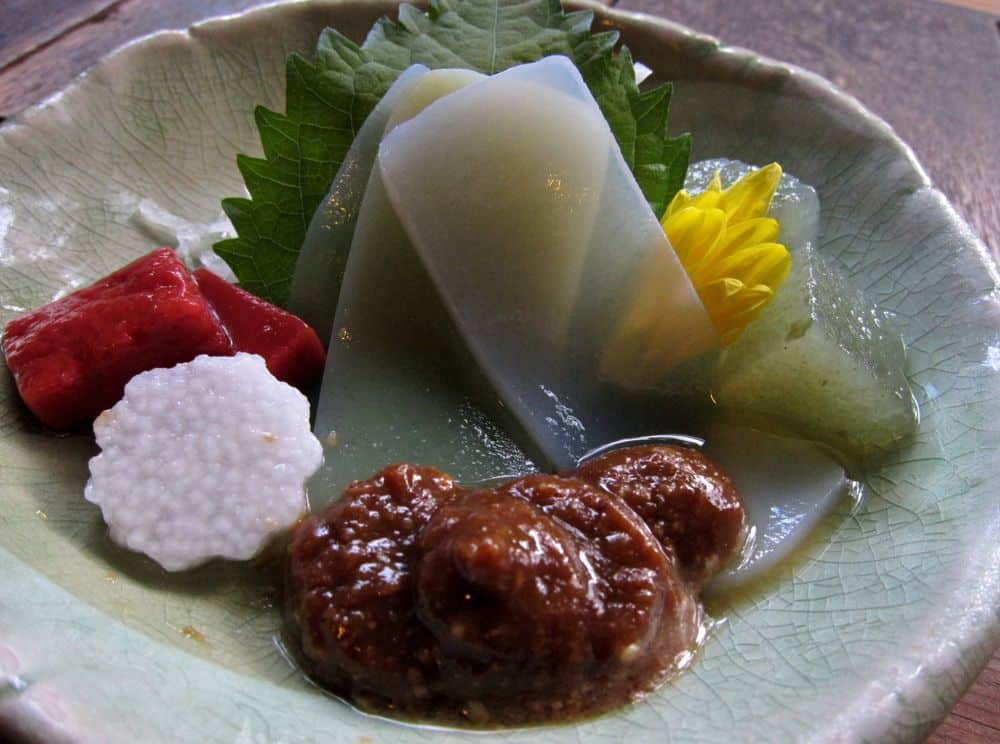
Konnyaku is known in English as Devil’s Tongue. It’s a jelly-like substance made from the root of the tuberous plant konjac.
It doesn’t have much flavour but is valued for its texture, which we found rather strange. It often features in shojin ryori (Buddhist vegetarian) meals. In the photo above konnyaku was served like sashimi with a dark miso sauce.
Mos Burger
Mos Burger is a fast-food chain, but the Japanese are rather proud of it and a local pointed out that the food is made to order and brought to your table unlike in McDonald’s.
The only vegetarian or vegan burger is the plant-based Green Burger, which is made from vegetables and grains and comes with teriyaki sauce.
You might want to add fries and onion rings for a more filling meal. Both are vegan.
You can order by pointing to the picture menu at the counter.
Mos Burger is a decent, quick, and cheap meal when you can’t find anything else.
Rice Crackers
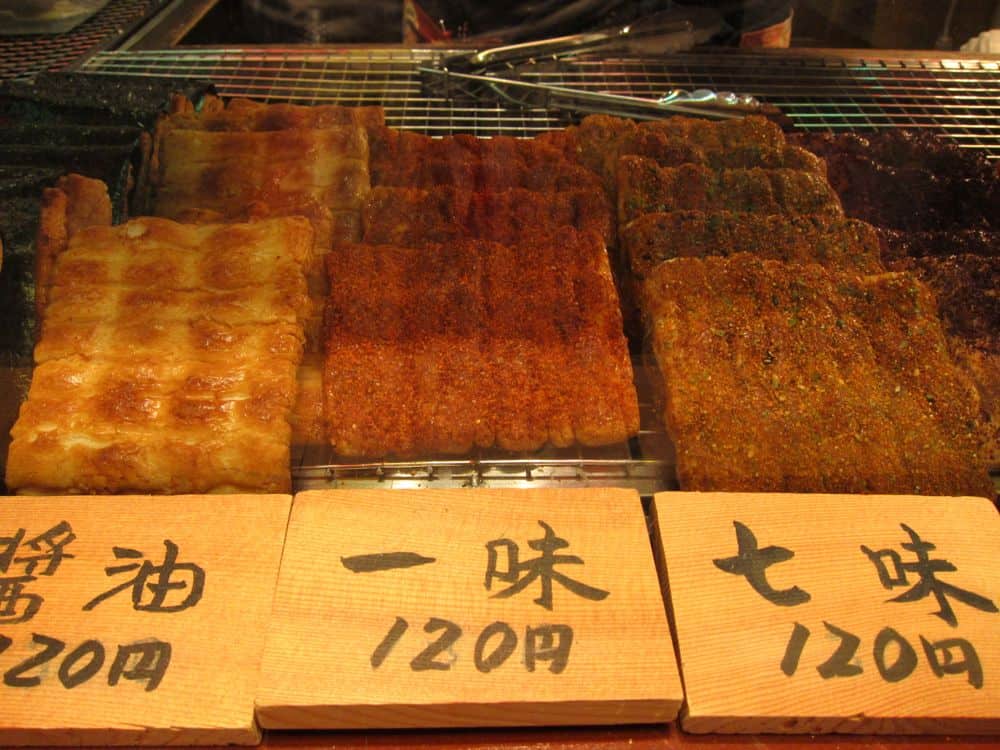
Rice crackers (senbei) are available everywhere from market stalls to convenience stores. Just make sure you don’t buy a packet containing dried fish or shrimp.
We picked up this crunchy, chilli-covered rice cracker at the Nishiki market in Kyoto.
Vegetarian Tofu Dishes
There is plenty of tofu in Japan and it is much higher quality than anywhere else in the world. There are even restaurants that only serve tofu in different forms for multi-course meals.
Be careful in tofu restaurants, though, as they aren’t usually vegetarian, and even if they can make a vegetarian meal for you, they will probably use dashi.
Sorano is a good tofu restaurant in Tokyo with vegetarian options marked on the menu, and Tosuiro Gion in Kyoto offers a vegan set. We tried many of these tofu dishes in shojin ryori restaurants.
Goma Dofu
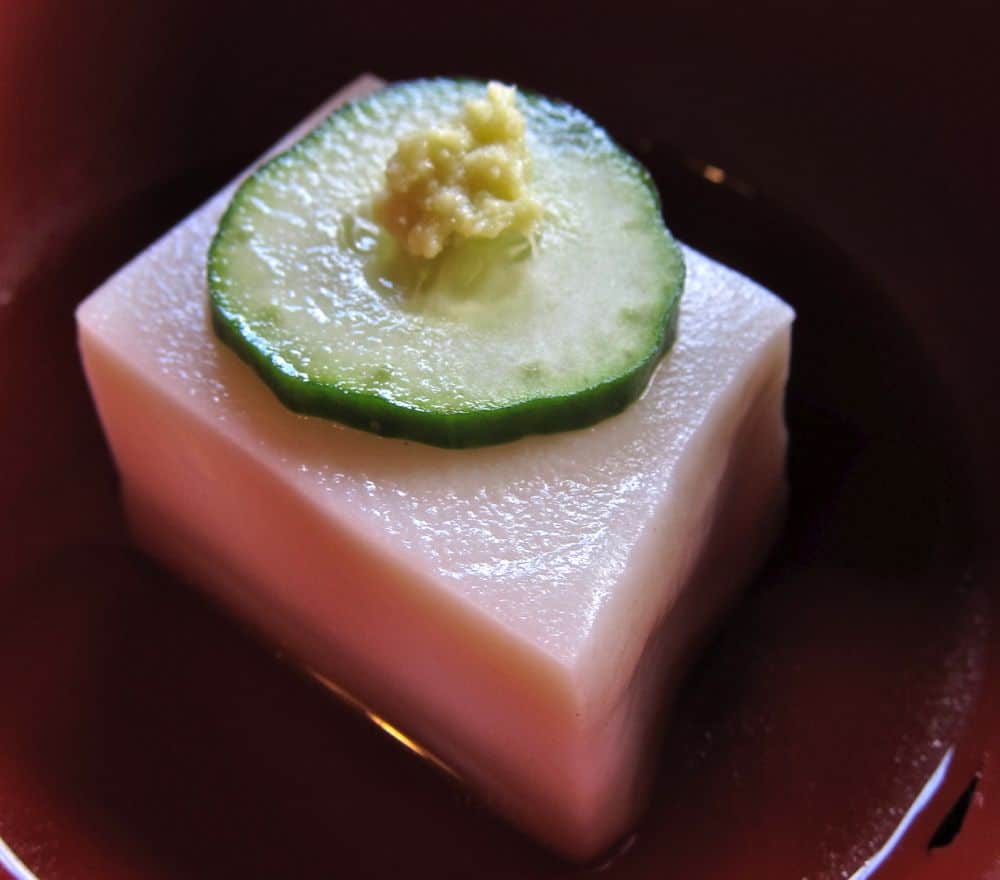
This chilled sesame tofu is one of the most common dishes in shojin ryori.
It’s actually not tofu at all as it isn’t made from soy milk but from sesame paste, water and kuzu, a thickening powder.
It certainly has a different texture from the tofu we are used to as it’s soft, creamy, and melts in your mouth. It’s a refreshing dish on a hot summer’s day. It’s usually served with a dab of hot wasabi.
Yuba
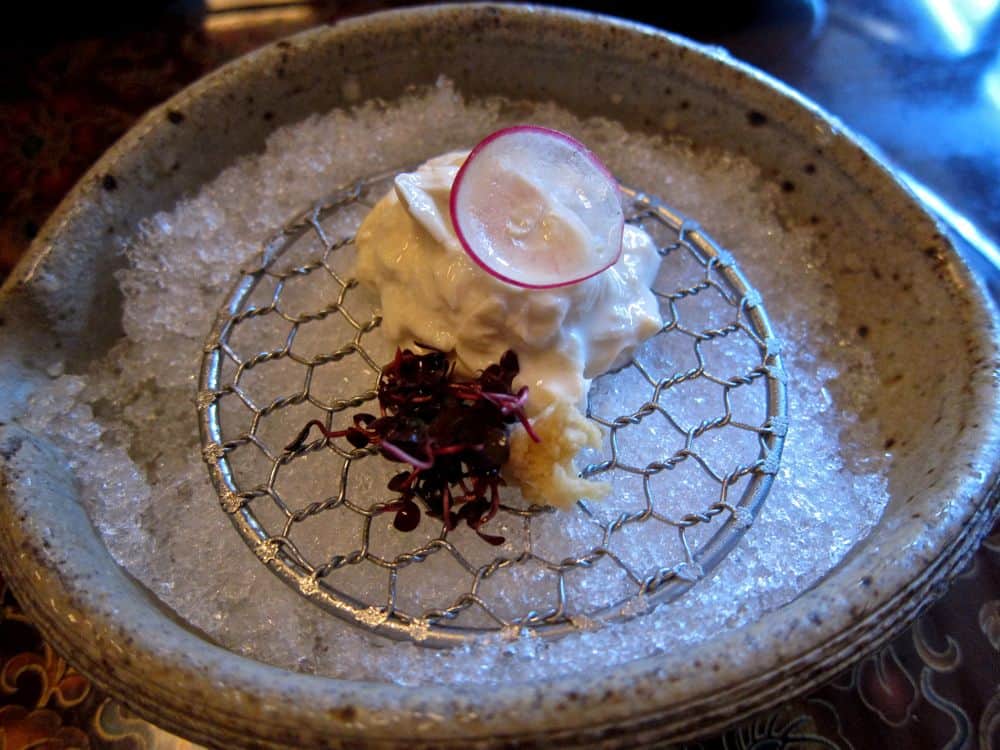
Yuba is made from the thin skin that forms on the surface of boiled soy milk—it sounds weird but it’s delicious, creamy, and light. It’s a local speciality in Nikko.
Koyadofu
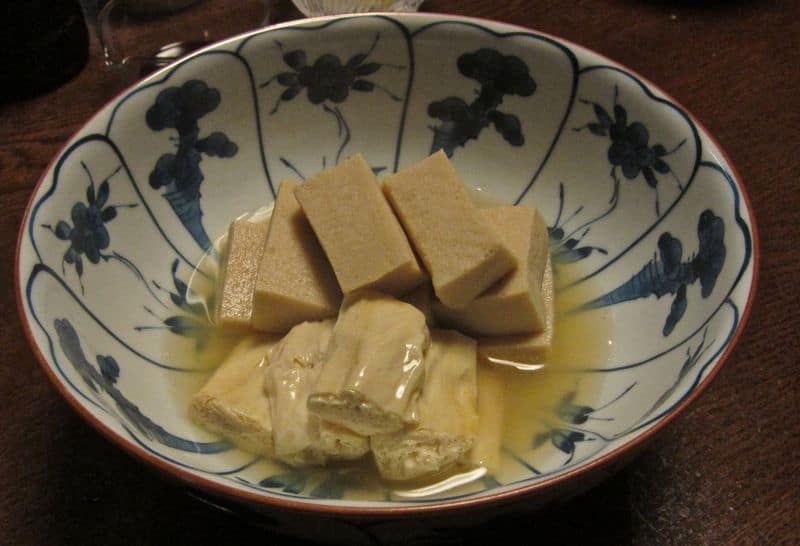
This freeze-dried tofu originates from the temple-filled Mount Koya. It is reconstituted in water and becomes springy and sponge-like, absorbing the flavours it is cooked in.
Yudofu
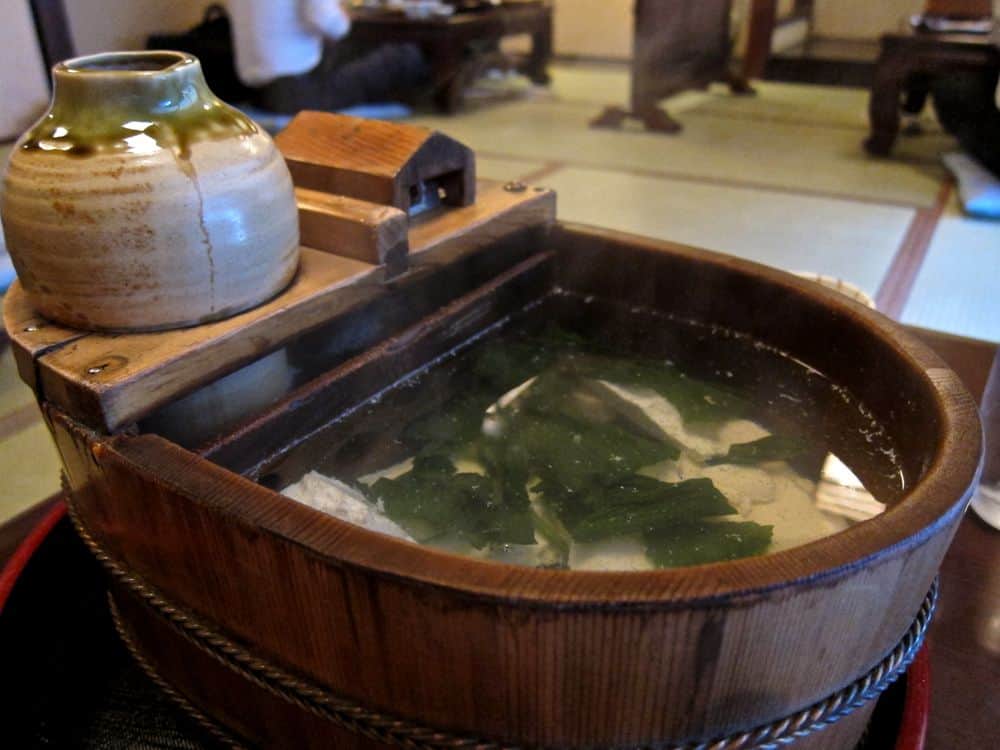
A tofu and vegetable hotpot that is simmered at your table.
Dengaku Tofu
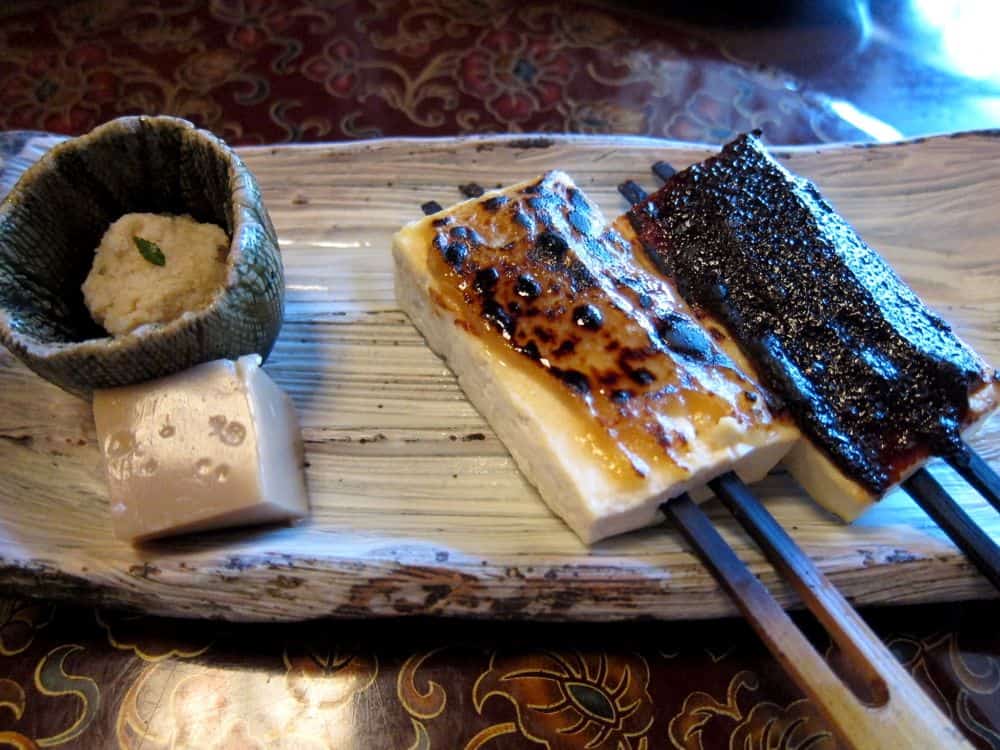
Firm tofu served on sticks dengaku style. It is coated with a sweet miso sauce and grilled until it caramelises and becomes golden and slightly charred.
Inarizushi
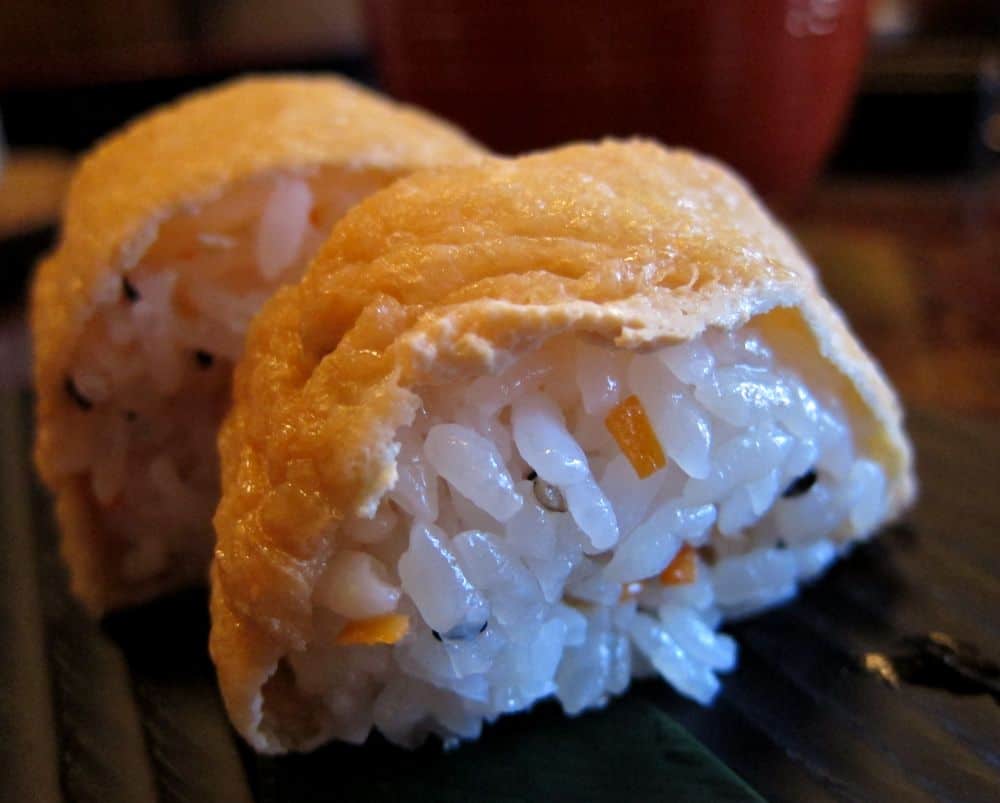
Vinegared sushi rice stuffed in a fried tofu pouch. We tried this at Tosuiro tofu restaurant in Kyoto and Yonekichi Akira Sushi restaurant in Nikko. It’s also sold in convenience stores.
Our Favourite Vegetarian Restaurants in Japan
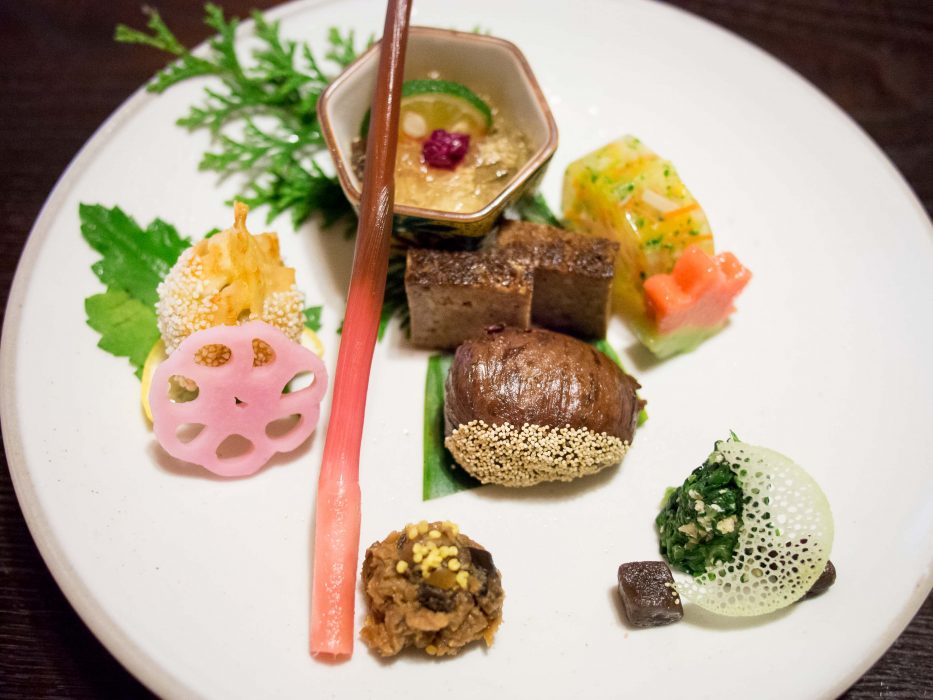
Tokyo
Tokyo has many options for vegetarians. Our favourite vegetarian restaurant is Bon, which serves exquisite multi-course fucha ryori in beautiful tatami rooms.
We loved the vegan ramen at Uzu and T’s Tantan. Zen is a vegetarian-friendly okonomiyaki place.
Read our guide to vegan and vegetarian restaurants in Tokyo for more details.
We also share vegetarian options in our guides to the Tokyo DisneySea and Tokyo Disneyland theme parks.
Kyoto
It’s easy to be vegetarian in Kyoto with so many options.
We recommend Shigetsu for shojin ryori at Tenryuji temple. We love the vegetarian set lunches at Hobodo Cafe.
Mimikou does delicious vegetarian curry udon and Vegan Ramen Uzu makes our favourite vegan ramen in Japan.
For more of our favourites, see our vegan and vegetarian Kyoto guide.
Osaka
Osaka is very vegetarian-friendly if you plan in advance. There are an increasing number of vegan restaurants including Green Earth and Rocca.
You can try local specialities at Matsuri and Okonomiyaki Chitose.
See our vegan and vegetarian Osaka guide for more delicious options.
Koya-San
In Koya-san you can get shojin ryori meals for dinner and breakfast by spending the night at a temple.
We also ate the set lunch at Bon On Shya International Cafe on the main street which is vegetarian but serves international food rather than Japanese.
Nikko
Yasai Cafe Meguri in Nikko serves a daily vegan lunch and vegan crepes.
Komekichi Kozushi has tasty vegetarian sushi options and is one of the few places open in the evenings.
Kawaguchiko
If you are heading to Kawaguchiko to see Mount Fuji, you can find a few vegetarian options.
Fuji Tempura Idaten has a vegetable tempura set (skip the miso soup). We also had a break from Japanese at the excellent Pizzeria Onda.
See our post about Lake Kawaguchiko for more details (including the best places to see Mount Fuji).
Takayama
Heinraku is a wonderful small restaurant in Takayama run by the friendliest lady and has pages of vegetarian options on the menu—I loved the Hida miso ramen.
Sukuya is a good place to try a vegetarian version of the local speciality hoba miso—vegetables and tofu cooked with miso paste on a magnolia leaf.
Kanazawa
In Kanazawa we struggled to find Japanese vegetarian meals so ended up eating Western food.
Slow Luck is a tiny place focused on using vegetables in creative ways and has a vegetarian menu. The food was Italian-inspired and utterly delicious including a pesto, potato and mascarpone pizza and grilled vegetables with an incredible pesto dip.
See our 2 week Japan itinerary for more details about what we ate in Nikko, Takayama, and Kanazawa.
Naoshima Island and Okayama
Naoshima Art Island is known for its contemporary art museums and iconic yellow pumpkin sculpture.
This small rural island doesn’t have many vegetarian options, but we did have a fantastic lunch at Aisunao, which focuses on brown rice. Their tasty lunch set is vegan and the miso soup is made without dashi (the noodle soups are not).
In nearby Okayama City you can get excellent affordable Indian food at Milenga.
Nara
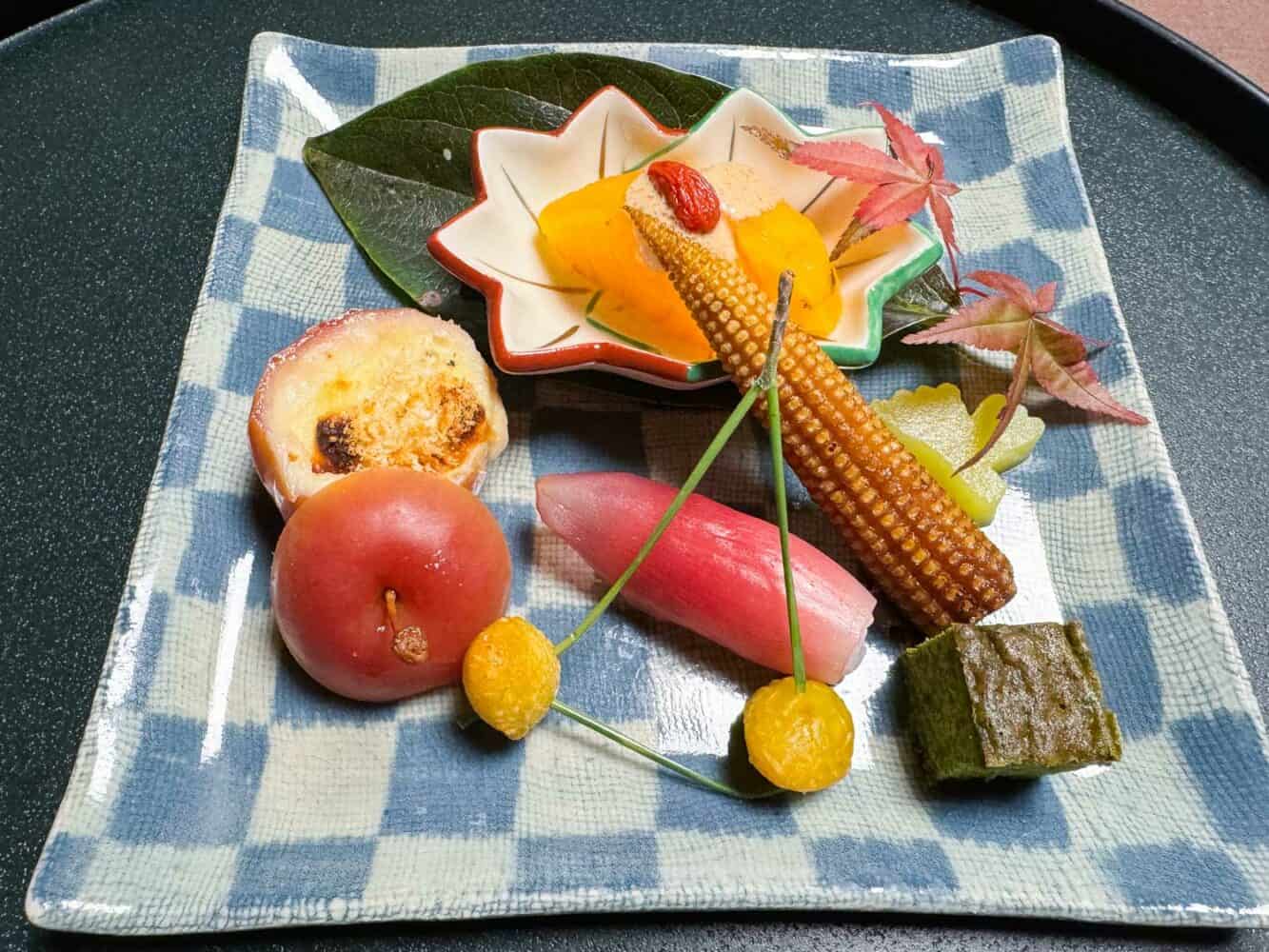
While exploring the temples, we had vegan udon in a thatched cottage inside Nara Park at Mizuya-chaya. It’s not the most exciting but it was quick and affordable and convenient.
We had an incredible vegetarian multi-course dinner in our ryokan Tsukihitei (the magical forest setting make this my favourite ryokan in Japan).
Miyajima Island
There are a few veggie-friendly places on Miyajima Island but our top two choices were full or closed, so we ended up having lunch at Yamaichi Bekka, which worked out well. Ask for their vegan menu—we had the tempura set and fried tofu/salad set.
We had another epic feast at our ryokan, Iwaso.
Onomichi
We visited Onomichi to cycle the lovely Shimanami Kaido bike path across multiple islands and really enjoyed our stay in this untouristy port town.
Vegetarian options are limited but we had good vegan curry at Coyote Cafe, falafel sandwiches at Hato Kitchen, excellent pizza and salad at Pizzeria Tranquillo (vegan pizza available), and bagels at Koro Bakery. There’s also a Coco Icibanya.
Shout out to Yutaka-san at Pour Speciality Coffee for the superb brew.
Summary
Although Japan can be challenging as a vegetarian if you just wander into any restaurant, with some planning you can find some amazing meat-free meals.
The delicious food is one of the reasons we keep returning to the country. I hope this post helps you enjoy it as much as we do.
More Japan Posts
Our Vegetarian Japan Guides
- Best Vegan and Vegetarian Restaurants in Kyoto
- Best Vegan and Vegetarian Restaurants in Tokyo
- Best Osaka Vegetarian and Vegan Restaurants
Japan Tips
- Planning a Trip to Japan: Dos and Don’ts
- 2 Week Japan Itinerary
- 16 Unmissable Places to Visit in Japan
- 26 Unforgettable Things to Do in Kyoto, Japan
- 26 Cool Things to Do in Tokyo
If you enjoyed this post, pin it!
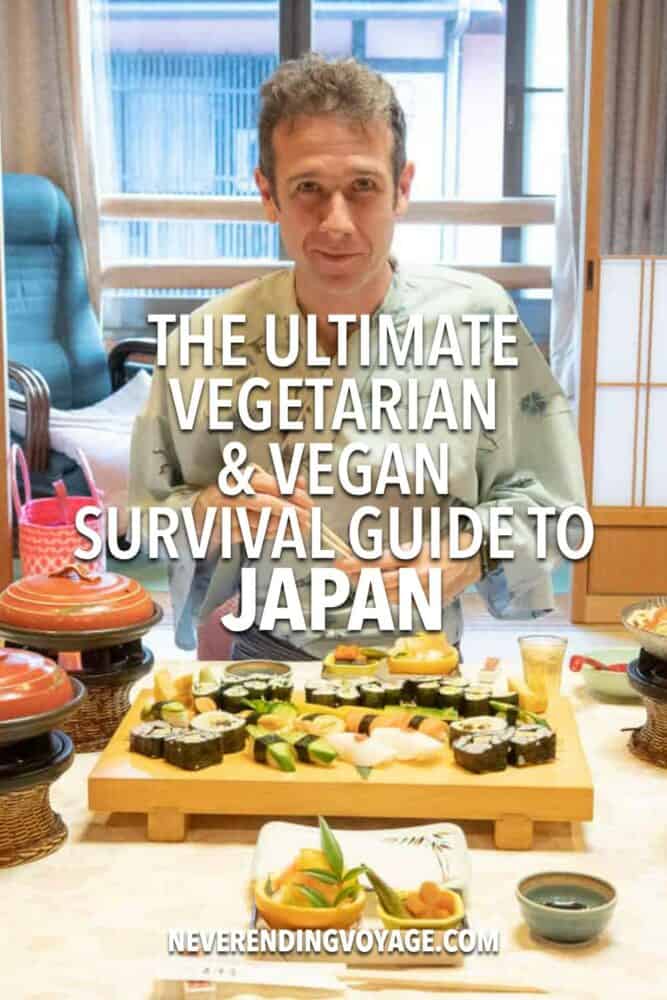
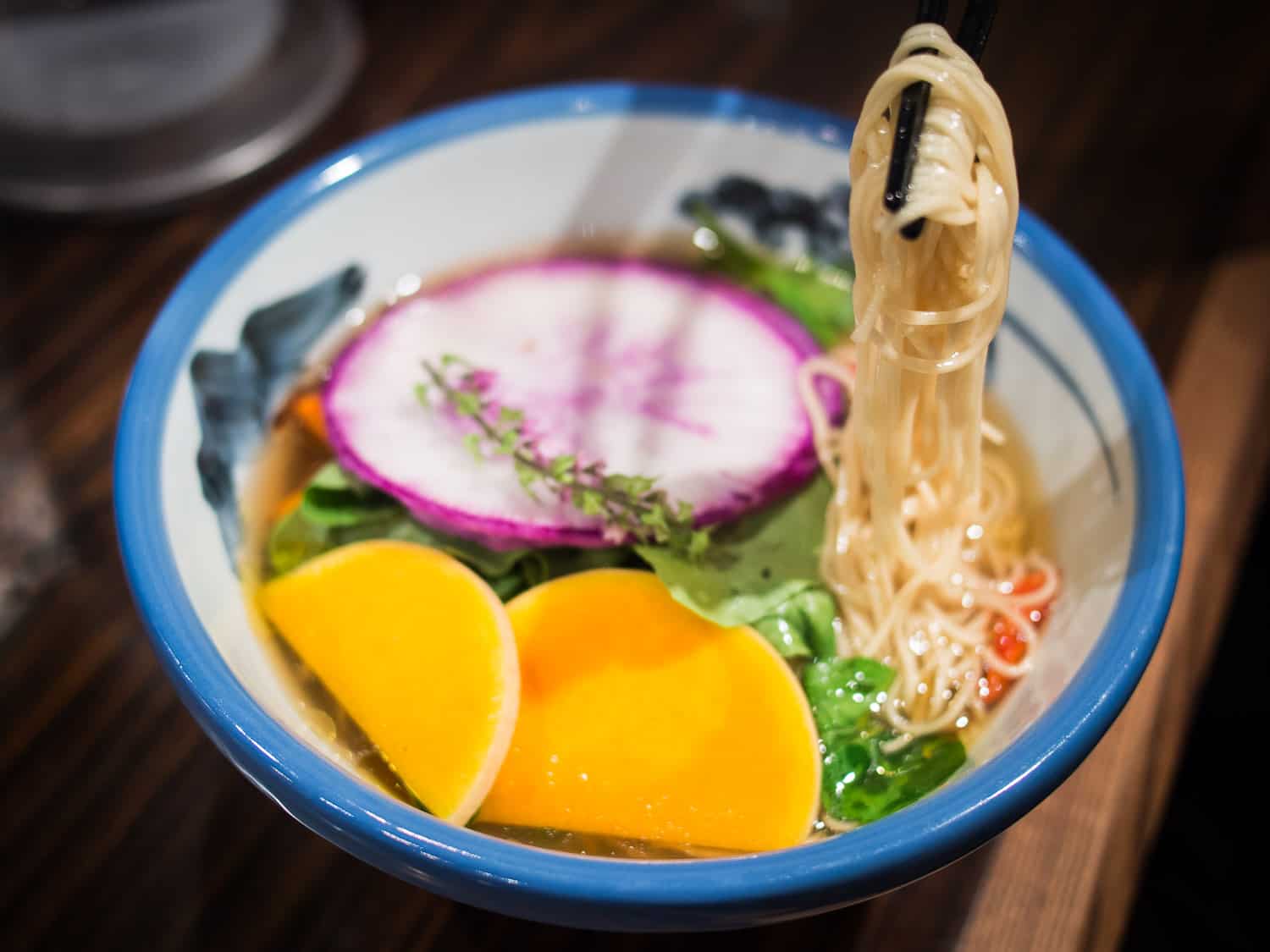
This guide is super helpful, thank you!
I’ve been a strict vegetarian for 10 years now and I’m traveling to Japan for the first time with a large group (all of whom are meat eaters) so, unfortunately, going to vegetarian restaurants won’t be much of an option for me. I’ve made the tough decision to be lenient about having dashi on this trip but I’m worried that I’ll get sick if I don’t prepare beforehand. I was just wondering what your experience was like and if you ever got sick/felt ill from eating dashi or any non-vegetarian broths.
We never got sick and I think it’s unlikely from dashi as it’s very mild – you probably won’t even notice. You could look on Happy Cow for restaurants that serve meat but also cater to vegetarians – there are more and more of them these days, so hopefully you can avoid dashi entirely. Good luck!
My wife and I, both plant-based, have travelled Europe extensively, but are contemplating our first holiday in the far-East, and thought that Japan would be a good starting point.
One of our first concerns was meals, and, my, what an incredible source of amazing detailed information this thread has provided us! I really appreciate the enormous time that you took to create such a comprehensive document…
Thanks so much, David & Alison
Thank you, David and Alison! Enjoy all the delicious vegan food in Japan!
Thank you for this! I live in Singapore and am vegan though I sometimes eat eggs when there is no alternative. Traveling to North Asia is like a nightmare for me. This guide seems invaluable as I am planning travel to Japan soon!
Thank you! Hoping it is going to help my husband who has become stricter with his vegetarianism. Hope to find places where I can have fish and sushi and he can be a vegetarian. Last time we were in Tokyo we frequently went to a place at the Shinagawa train station that made an excellent vegetarian Bagna càuda – although I would guess the sauce was not strictly dash or other fish free.
What an excellent post! Thank you so much. Our 11-year-old son became a vegetarian 3 years ago and after 2 previous trips to Japan we were worried about dining during our upcoming trip. This will be so helpful and we can’t wait to try some of your suggestions.
Thank you and enjoy Japan!
Hi, I am Japanese and working in inbound marketing field as a consultant. I just found your page and read this article. Your guide was amazing. I am trying to expand vegetarian/ vegan food culture more across Japan, your work helped me to understand what people struggle with in Japan. If you do not mind, would you give me some more hints to understand? Like, what do you think Japan needs to improve quickly to welcome those people who are vegetarian/ vegan? I would really appreciate if you could help my journey! Thank you
The main thing would be restaurants offering vegetarian/vegan options and marking them on the menu so that it’s clear what is meat/fish free. Also understanding that vegetarians don’t eat ingredients like dashi.
hey! I just loved the way you mentioned everything in detail. Would love to be a blogger one day just like you.
thanks.
Just amazing guide, thank you so much for that. When we first went to Japan in 2019, we have discovered only a few of the several options you have described here. I’m looking forward to coming back to Japan and try everything listed here. Cheers!
I’m glad you found it useful, Vinicius. I hope you make it back to Japan to try some more delicious food!
Amazing work! The way you organized with the explanations, great! Hats off to you sir!
-Love from India
The ultimate guide! I’ll be moving soon to Tokyo from India. Your tips will surely make a difference.
Good luck with the move and enjoy all the delicious veggie food in Tokyo!
Very nice guide.
I am living in Japan for 4+ years. Being vegetarian is difficult, no, it’s “super” difficult, I realized after I travelled Australia and New Zealand!
Your post is super useful for people who want to travel. But for people who want to spend their life here, it’s still frustrating you know. A person can easily get bored when there is no variety in life.
I kind of implemented strategy, control my tasty tongue and be minimalistic about food when traveling village side, when at home cook at least one time (which many people dont like to lol) and last option is always indian restaurant or italian (which Im totally tired of going in this 4 years, even being indian I am hating Indian food now!! bcoz no variety in that too)
But tokyo is improving, lots of veg restaurants are opening or turning to veg. I hope in coming 4-5 years there will be massive movement toward veg options…
I am pretty sure this post will help a lot to travelers. Thanks for sharing!
Thanks, Jay! I can imagine it is a struggle in the smaller places. At least options in the cities are definitely improving and hopefully that will continue. Good luck!
You are a savior. God bless you :)
Keep up.
Aw, thank you :)
Hi;
Just to let you know, Mos Burger’s soy vegetable burger is not vegetarian.
(They will print you a list of ingredients, if you ask).
Thanks for the info – I’ll update the post.
Very well written! Going to Japan in October this year, I am sure these tips would come handy :)
Thanks again! Keep travelling and sharing your experiences with the wider public :) If you ever visit New Zealand, please let me know. My husband and I would love to catch up and hear your travel stories
Many thanks,
Nitisha
Thank you and enjoy Japan! October is a great time to visit.
Hi we are planning from 8 th June to japan.
This information is very good for Indian people
Thanks a lot.
I’m glad it helped! Enjoy Japan!
From India and following strict vegetarian diet (no eggs) this webpage is a blessing. Great inputs and very simple guidelines to follow. I would be using these inputs for my upcoming trip to Japan. God bless you.
I’m glad you found it useful. We’re in Japan again right now and have found even more delicious vegetarian food. I’ll update this guide soon!
Wow. I really loved seeing just what kind of variety of awesome and beautiful vegetarian food you were able to enjoy in this amazing country. I have long been enamored of Japan since my school days, like many people, and have sorely wanted to visit and study the culture. I did have reservations about being able to survive there as a vegetarian, as I was aware it can be rather difficult there. But great to see your example of thriving over there on a vegetarian diet! Makes me so hungry and eager to taste the food.
You’ll do fine with a bit of planning. There is so much delicious food here!
Wow ! i liked your post,I want to let my mm go there but she worry because she is vegetarian. Thus, i have a chance to let her to Japan once for her life, Thanks
I hope she enjoys Japan! It’s definitely possible for vegetarians with a little planning.
Hi Erin,
Thank you so much for this informative post. I am leaving for Japan in a week’s time and going through your post made me felt like I hit a jackpot. Being a vegetarian, I was wondering my food options in Japan but your post is a savor. Thanks again!
With a bit of planning you can eat so well in Japan – enjoy!
Man, I’m just leaving Japan and found this Article extremely helpful! Wish I would have read it sooner when I arrived on March 28 (day it was written?) but atleast now I get to enjoy one last vegan meal tonight in Tokyo! Thank you so much for the tips!
Sorry you didn’t find the post sooner, Kate (it was actually first published many years ago but was updated in March). You’ll just have to return :)
I don’t eat is just tabemasen not taberarimasen, from the verb taberu with the negative conjugation on the end. Taberarimasen could be confusing if you are saying it to Japanese people as it kinda sounds like ‘meat is not available to be eaten’, not ‘I don’t eat meat’.
Thanks Kotoni, I’ll update the post.
What a DELICIOUS post this is Erin :) It was hard for me to get to the end of it without visiting my fridge and grabbing some food. Kabocha Korroke – those must be very tasty, I will give them a try as soon I will get to Japan.
Hello!
I am going to Japan for a long time to come, and your TravelBlog is best guide to people like me.
May i know is your vegetarian contain onion, galic, spring & Alcohol? May i know is there vegetarian restaurant in other places beside tokyo?
We do include those things. There are vegetarian restaurants outside Tokyo – use Happy Cow to find them.
omelet rice didn’t make the cut?
We’re not a fan of eggs.
Has this piece been updated at all? Hard to tell
I often find that with sites like yours, ones that offer such an exhaustive compendium of tips and lists, I am severely disappointed by the lack of a downloadable sidebar containing the names of places/locations, etc. mentioned. You are so detail-oriented otherwise, so I don’t get it.
Sigh.
Keep up the good work though, and maybe one day you’ll figure out how to either give us a download link, or a cheat sheet at the end of the post we can copy/paste. Not all of us are armchair-travelers, some of us are on the road too! Then, your site would truly be awesome.
Thank you so much for sharing this helpful information. Now I can worry less. Do you think I can find the same food you mention in Tokyo too?
Yes, you should have plenty of options in Tokyo. Use the Happy Cow app to find vegetarian restaurants there too.
Wonderful post. I wrote my vegetarian survival guide after surviving for two weeks in Japan here.
In Japan I eat a lot soba and Japanese vegetables because if we try to eat what we have in our country, it is often too expensive …
In the opening comments on the website you mention, to say you don’t eat fish or meat is better than saying “I am a vegetarian”. This is true. But I find even when you say I don’t eat fish or meat, this is still open to thinking you may eat shellfish, octopus, crab, lobster, shrimp, prawns, ham, pork, chicken, sausage, hamburger, and so on. I don’t know what is the answer, except to add some of these to the answer you suggested, that is …….niku ya sakana ya kani ya ebi ya butaniku ya toriniku wo taberarimasen…… and leaving it open by using ya.
Just want to give you both a heart felt thanks for creating this site and providing such a detailed guidance for vegetarians. Too bad I did not find your site before making all the bookings. I will have to miss out on temple staying! Once again, thank you so much! And what an adventurous life you too are living :)
Thank you for your kind words and I’m glad you found the site useful. Have an amazing stay in Japan!
Thank you for positing this warning. It’s very depressing to see such limited options in a supposedly civilized and sophisticated country like Japan. It sounds like traveling there for a vegan or true vegetarian (e.g. no fish) remains very difficult.
Amazing Website , Chanced upon it today. While yes Vegetarian Japanese food is what one should do when you visit japan, on my visit to Japan on a holiday, Tokyo in specific, two vegetarian choices stood out
1) Veg Ramen at T’s Tantan inside Tokyo Station for a taste of Japan.
2) Indian Food at Vege Herb Saga, brilliant vegetarian food in case u dont mind it for variety
thank you for this post!
This article is so helpful! I’m a college student minoring in Japanese and I love the language and culture of Japan. I am vegetarian and going to Japan soon with school and I was extremely nervous about going to Japan as a veggie. But this article made me relax a lot! I can’t wait to go to Kyoto!
Kyoto is a great destination for vegetarians as long as you plan in advance. Enjoy!
Awesome site and so useful. Today I had several wonderful meals – tofu placed in boiling water with a candle underneath, served with a sesame and soy sauce. Simple – but yum.
Wah.. great post! Yes, I’m vegetarian and definately looking for some posts like this one! You got it!
Thanks!
Hi..Wanted to confirm… r all noodles & spaghetti in stores in japan vegetarian? I m unable to read d ingredients…
I don’t know for sure but I can’t imagine what they’d put in them to make them not vegetarian, as long as you go with the plain ones (i.e not packet instant noodles with a sauce). We bought fresh noodles from the fridge section all the time in Japan.
I’m applying to work as an Assistant Language Teacher in Japan for a year and am apparently unlikely to be posted that near the larger or more touristy cities. After reading this and a few other articles i’m now very worried about how I’ll maintain my strict ‘no meat, no fish’ diet for that long if I’m away from places most likely to have veggie restaurants?! :o
I’ve been vegetarian for 16 years now and don’t want to stop (don’t think I could!) Is it best to just stick to home-cooking my own food for the whole year and only order rice or noodle dishes if they’re plain and non-sauce based?
The toughest thing will be avoiding fish stock which pops up everywhere. I would stick to cooking for yourself where possible and ask locals for advice about what to order when eating out.
I have lived in Japan now for 24 years in the provinces. I am a vegetarian. It has not changed that much from when I came. Most people will ask me while eating a meal why I am a vegetarian. In the UK or the States and similar countries I cannot imagine someone asking me that question because the concept is so familiar. I really think that nowadays with the internet and Youtube and suchlike, there is no excuse for anybody from a rich country not to know about these things. But unfortunately, most of the information about animal rights and vegetarianism/veganism is in English which means that the Japanese are effectively shut off from knowing about it. I find cooking and eating here a chore. By the way that brown sauce on your okonomiyaki is not vegetarian!! There is one I have found without meat extract in but they won’t use that one in restaurants. And I used to buy the vegetable croquettes years ago from the supermarket until one time, the nice women working at one, actually brought me out the box they come in so I could check the ingredients and there it was, written on the side – chicken or pork or something or other extract. In supermarkets there are no vegetarian curries at all out of the dozens of types (do not go for the ones that say Vegetable Curry as they are meat ), hardly any spaghetti sauces (unless they are imported brands in glass jars), no veggie soups (unless you go to an import shop) and you have to check every dressing you buy. And the only sandwich in convenience stores you can eat is egg. Even that may have gelatine in it. And it is always only egg, as if you cannot ever have anything else with it. If I go out with my Japanese friends, and we go to a Japanese restaurant, it is hard work. Honestly it is a nightmare. I love family restaurants here, however, esp Gusto as you can generally get a salad and a pizza (I have not asked to see the box – some things are better unknown!!) So I would recommend family restaurants. Good luck!
When you say you looked at the box for vegetable croquettes I wonder what these were? Can you add more precise description? I often buy kabocha korokke (pumpkin croquette), at the food halls and supermarkets, where the vender, as far as I can tell, makes them fresh in store.
Thanks heaps… great help…travelling to kyoto, osaka and tokyo this week
m a lacto-vegetarian.. travelling to japan next month with my family.. will be stayn in yamaguchi… this hs bn a very wonderful post.. very informative… kindly comment reagrding availability of low-priced vegetables & fruits for self-cooking in japan…. plz let me kno which r d cheapest vegetables there, which cn b used as staples..
My own research seems to imply that the price of vegetables is fairly high but will be very fresh/high quality. The price also varies according to what’s in season.
Wow!!! A great compilation. Am a huge fan of japanese food and everything here looks so delicious. Although, I have never visited japan and currently stay in Bangalore but I have come across a great place in Bangalore for japanese food. Davanam Sarovar offers really delicious japanese food and the sushi there is just exquisite. Japanese food-lovers in Bangalore must try out this place at least once.
A great list here and very helpful during my trip to Japan! With reference to Mos Burger, the Freshness Burger chain also do a veggie (bean pate) burger which is also hand made- another Japanese burger chain which prides itself on the home made/health credentials! this one’s pretty filling and a similar price.
Google map of Freshness Burger outlets in Tokyo
Like Mos Burger, it’s pretty easy to point out the picture on the menu, or if you just ask for ‘veggie’ people tend to know what you mean, and being Japan they tend to help you out if you’re struggling anyway!
Thanks to you, I can again dream about living in Japan as a Vegetarian. Thank you for your wonderful topic.
Wish you a “Never Ending Voyage” ;)
I spent two years in Yamagata Prefecture as a member of the JET Program and I survived as a vegetarian. It helped because at my orientation, I received “a bible” or sorts for vegetarians in the country and it was a godsend. The book contained recipes for Japanese vegetarian meals as well as vegetarian friendly restaurants in Japan. I took that book with me during my travels and I couldn’t have survived as a vegetarian without it.
Thanks for the thorough roundup. I do eat fish every now and again, and while I know that won’t count me as a vegetarian in some circles, over half the time I usually just go vegan, so this post will definitely come in handy when I set off for Japan this fall.
All, If you are going to be visiting Osaka, then there is a very cute vegan restaurant called “Green Earth” beside the Kaiyukan (aquarium). It is a lunch-only buffet, very reasonably priced at 750 Yen. A nice day trip could be to visit the aquarium, eat at the restaurant and then go for a cruise at the nearby harbor.
Thanks…a very informative post !
Thank you so much for posting this. It was very comprehensive and will be helpful when I journey to Japan for the first time in December 2014. Thanks!
Thank you very much good info :)
When I visited Japan there were 2 vegetarian girls in my hostel and they were struggling a lot. They ended up eating buns from 7eleven for a whole week… so I’m glad there are a few spots you can eat at as a vegetarian! :)
Oh no! We actually really enjoyed the food in Japan but it does take some planning.
Hello from Hiroshima. I just thought you might want to know the Vegan Cafe which was mentioned in the article was unfortunately closed.
Thanks for letting us know.
This is so helpful and informative! Thank you for putting this together. That pancake looks incredible. I’ve been living in Taiwan a while now and there are vegan options galore. Check my blog if coming here to visit too! Happy travels.
Wow! I’m going to read all these guides when I trips to these countries, first being Japan. SO helpful :D
Thanks for detailed information, very useful.
Eggs are not vegeterian.
Wonderful info!
I am afraid Ragamal (the Indian restaurant) in Nara has been closed since the beginning of March 2014.
Thank you for the guide. I’m going to Japan in July and this was helpful in understanding what to expect to eat as a vegetarian in Japan.
Thanks so much for all your vegetarian guides around the world! I’m currently living in Hanoi, Vietnam and at first I wasn’t quite sure how to survive. Like you, I wanted to help fellow vegetarians find some local dishes to try and as you haven’t included Vietnam in your guide, I wanted to share it with you!
/
Thanks for your info, it’s all good to know!
on the Okonomyaki – the Worcestershire itself is not vegetarian!
I’m going to Japan in September for my gap year, and after reading so many negative articles, it’s reassuring that you have managed to find so many vegetarian dishes. Does anyone have any ideas about how it is to go grocery shopping Japan as a vegetarian?
We were house sitting so went grocery shopping often. It is a bit confusing at first as almost all the labels are in Japanese so we struggled to even know what soy sauce was. Getting a local to help you out or using a translate app might help. Good luck with it.
Hi,
Thanks for the tips!!
Just wondering, what type of cooking oil they used to fry i.e fry tempura? Is it vegetable oil or lard?
Sara
I’m afraid I don’t know for sure. We just assumed it was veg oil.
hi from Japan. for frying tempura, they traditionally use vegetable oil or canola oil because those oils determine the flavor of tempura. If they use lard, I guess it would spoil the taste.
I thought that might be the case but it’s good to have it confirmed.
Being flexible is probably the most important point in this guide. I’m glad you included that.
I’ve been living in Japan for several years and when I first came, it was hard to be flexible. When I loosened up a bit when I went out to eat I found that I was less stressed and that I could focus more on enjoying time with my friends.
Since not everyone is fluent in Japanese it should be expected that there will be times when you accidentally consume animal products. Just remember about it the next time.
Also, here is a restaurant guide for Tokyo: http://vege-navi.jp/
Hi Mr Erin And Family thanks for your homework on the Eco friendly Vegetarian People who wants to visit the lovely place on earth JAPAN having good hospitality as you felt and expressed in your tourist guide for the whole lot of food . we the first time visitor to Japan along with my good hearten friends from Bangalore , India fell proud of your fmly and a small request at the end of this Trip to japan i too will find some place in this for latest information as you did which help other too to be Vegan .
By Happy New Year 2014
Hi Erin,
This section looks like a relief as I will traveling this week onwards to Tokyo/Kyoto and Nozawa. Thank you so much. And would request you to pls suggest about some Veg restaurants in Nagano Village too?
Until Happy Traveling :)
Best wishes,
Vidya
I am looking or more information about veggie restaurants in Tokyo, Kotyo, Nagoya . we are25 peoples plaing to Japan next year. all of us is vegetarian (no onions but we can have eggs.)
http://vege-navi.jp/ is good for finding restaurants in Tokyo.
If you can read Japanese this site may also be helpful;
I found this, it covers restaurants and at least some shops http://www.happycow.net/browse.html On the website you can search anywhere, the app (which is free!) works on GPS and so will kick-in once you are there :) Scarlett
This has been an amazing find! As a vegetarian, when I go on exchange I figured that I would just buy my own food an make. Will definitely stop by Kyoto. Thank you, this has been most informative! :)
Thanks so much for the awesome post! I visited Japan a few years ago and struggled through rather unsuccessfuly with “watashi wa bejitarian des”. I am going again in a couple of months and think your post will make a big difference. Thanks for the simple phrases, useful photos and suggestion on things to eat and places to try them!
Hi, Loved the detailed explanation. I am from India and you probably know that vegetarian in India doesn’t include egg. Have you ever visited India ?. The amount of Vegetarian food you get would be mind boggling. I am sure you would like it.
We did visit India for 3 months 5 years ago and it’s one of our favourite countries and a definite vegetarian heaven. We really have to go back soon.
In English there are actually separate defining terms for all of them;
Ovo-vegetarians don’t eat eggs, meat or fish,
Lacto-vegetarians don’t eat milk products, meat or fish,
Vegetarians don’t eat meat or fish,
Pescatarians eat fish but not other meat (this one makes no sense to me),
and Vegans don’t eat eggs, milk products, fish or meat.
Unfortunately, almost no non-vegetarians know the difference and some restaurants in England still list fish-based meals as vegetarian. :/
I would love to visit India!
Abi – I don’t know what English speaking country you are referring to, but in England, the UK and all parts of Europe I’ve ever been or lived those first two terms mean the opposite of the meanings you give!
Ovo vegetarians eat no insects, crustaceans, fish, meat or animal by products EXCEPT for eggs.
Lacto vegetarians eat no insects, crustaceans, fish, meat or animal by products EXCEPT for dairy products.
Meanwhile, Ovo lacto vegetarians eat both dairy and eggs and are, being the most common ‘type’ of vegetarian are what a person is most commonly referring to when they say ‘I’m a vegetarian’.
Just further shows – understanding what a person means by ‘vegetarian’ can be a nightmare anywhere.
Far as I see it / was raised (been veggie all my life) understanding that if an ingredient / product required an animal, insect, fish or anything other than a plant to die it don’t matter if it is a pork chop, flake of fish or a piece of candy / gummy sweet containing gelatin – a vegetarian would not eat, wear or use it, or anything made using or containing it. It’s the same definition the Vegetarian Society gives and the NHS in England. As such, the NHS even vegetarian vaccinations and tablets etc.
Meanwhile, a vegan follows a veggie diet, but also excludes eating and wearing by products from anything alive excepting plants.
Thank you very much for posting such a useful information. Now I got a clarity on Japanese Veg food. Again thanks a lot.
Great website and information! I am a strict vegetarian (no primary or secondary consumption of animal products). I frequently visit Japan since my family and I live in Korea, so I am always on the look-out for new ideas for meals while there. You have some great ones that I hadn’t ever thought about–thank you!!!!
Your passage on flexibility is very wise advice for the plant-based folks living in Asia. Know excatly what you are eating; do your best; make the best choices possible under your circumstances (Ex. Yes, the udon soup has trace amounts of katsuobushi oils, but there ain’t another restaurant anywhere near and your kids are hungry and cranky–as are you–
and the noodles there rock . . . so what do you do? Answer: Be flexible {just don’t drink the soup or wash your noodles in a cup of warm water or something}). After 13 years living and traveling in N.East Asia, this is the only way I have found to to make it on a very restictive diet.
Flexibility also goes a long way in not annoying the heck out of your spouse and children too.
My family and I are going to Kyoto next week, so I can’t wait to dig into some great food.
Thanks again and keep fighting the good [culinary] fight friends!
Although I can’t be certain from a photo, in the picture labeled “Dried fish on okonomiyaki”, the grey shredded stuff looks exactly like tororokonbu とろろ昆布 (grated kelp) and not much like the dried fish that usually tops okonomiyaki. Tororokonbu has a fishy taste because it’s seaweed.
As one of your other commenter mentioned, the grated fish on okonomiyaki usually looks alive because the fine paper-thin flakes move from the heat of the dish. Tororokonbu is more like a matted nest that doesn’t look like seaweed until it gets wet.
I could be wrong, but I’m pretty sure your friendly Hiroshima okonomiyaki maker understood your needs, at least with that ingredient.
As a side note, tororo とろろ (without the konbu 昆布) is completely different, but also vegan (or should be). Tororo is grated yam and is a white sticky, delicately flavoured mess often served on top of rice. An acquired taste as with natto, but more because of the texture than because of a strong flavour.
Oooh, that makes me feel a lot better! I do find seaweed to taste fishy and don’t eat it much so that could explain it. One of the problems for us in Japan was being completely unfamiliar with so many of the ingredients. Thanks for letting us know!
I don’t think I would have eaten tororokonbu until someone told me what it was. I have seen too many grey shredded dried animal parts in packets in supermarkets here to risk it.
I’m glad my post made you feel a little better. It’s never nice to be made aware of dietary indiscretions after the fact, and even worse when you feel forced to eat something you don’t want to.
I’m a bit late here but am sorry to tell you that I have never seen an authentic okonomiyaki recipe that doesn’t have dashi in the batter! And they make the batter up in bulk in advance so getting some without it seems pretty unlikely… It’s what gives it that distinct Japanese taste so if it was missing, I think people would find it doesn’t taste quite right.
And wow, Japan is an expensive country? Seriously? Wherever you’re from must be cheap because compared to Australia everything in the supermarket there is a bargain!
I’m not vegetarian, but I rarely eat meat apart from chicken breasts. I must admit there is a huge variety of vegetarian dishes served in Japan. They all look so delicious. I would definitely go for Yuba, soymilk skin tofu :)
Just back from our second stay in Japan, our daughter lives and works there. We are all vegetarians (no meat, fish, gelatine etc). We ate twice at the Vegan Cafe in Hiroshima, great food and extremely good value. We can also recommend The Green Earth cafe in Osaka and Modern Ark in Kobe. In Tokyo we ate three times at Chaya, a macrobiotic restaurant that is located in a department store in Shinjuku, . They have a few fish dishes but everything else is mainly vegan and the quality is fantastic. Proverbs cafe 15:17 in Kyoto is also good. We have the luxury of a Japanese speaking daughter but if you can stick to the veggie and vegan establishments, good to give your business to anyway, it is certainly possible not to compromise your principles. What a fascinating country and lovely people. Everyone should go if they can!
Thanks for the tips!
Some vegetarian relatives of mine in Tokyo took me to a great restaurant in Azabu Juban called “Eat More Greens”. I’d definitely recommend it to any vegetarians visiting the Tokyo area.
Thanks for the tip!
Thank you for this helpful and informative website. I wasn’t crazy about eating meat in Japan because they like it rather fatty, compared to how we like it in Canada. When I was there I was always trying to figure out what was vegetarian. Next time I go, I will be on the lookout for some of the delicious foods you’ve been kind enough to show here. I wish I could eat the grilled eggplant right now!
I think I am just going to print this out and take it with me when I go to Tokyo next week. So excited to try out all these new varieties of food. Thanks to you, now I can.
My3
I hope you find it useful and enjoy!
Are you guys vegetarians? I used to be, but gave it up when being in China for 10 months. People did not understand the concept of vegetarianism at all. They gave me dirty looks and made me eat some meat. Basically, the whole Chinese cuisine is based on meat and noodles, so I broke. How about in Japan? Do they understand it?
We are. The Japanese often don’t understand the concept but saying we don’t eat meat or fish in Japanese usually worked. Kyoto is great though because of the culture of monks being vegan so there are plenty of vegetarian restaurants.
I’ve always wanted to know about Japanese vegetarian food. Your post provided great insight, and photos, from a fellow food lover.
Good luck on your travels!
I hope you can come to the Philippines, too!
Neil
Hello!
This is fanbtastic.. I think you guys have helped unravel the mystery for us vegetarians who have always wanted to travel to Japan, but were daunted by the limited food options :)
I hope to travel there sometime soon.. looking forward to it.
All the best with your globe trotting adventures!
Cheers!
Thank you so much for this great article!! I’m so excited to see that as a vegetarian that doesn’t eat fish I will have a LOT of options in Japan. Great, thorough article!
There are lots of options in Kyoto, less so elsewhere but it is possible. Good luck and enjoy!
Guys, I love you. I am visiting Osaka + Kobe for a month and this thorough compilation is a god-send. I spent my first week cooking “everything” at my place but I felt a little guilty at not getting a chance to sample the local cusine. One thing that did help me shop at the super market was to have some one write out “saishokyu shyugi” (I think it means vegetarian) for me in Kanji and show that to a store attendant to help me pick out the vegetarian items. I did find some delicious stir fry sauces that way.
Glad it helped Mrinal and great tip about writing out the kanji for vegetarian- glad it worked for you.
If you stayed in Japan long enough, you will find that most of it is either miso-based or shoyu-based.
Just returned from Japan. We had good luck starting with tourist information centers. We suggested that we wanted to find a restaurant to try local specialty X (or just Japanese food X), but the problem was that we don’t eat meat or fish. We then suggested that it might be possible to make X without fish broth, etc., and wondered whether there might be any restaurants that would be able to prepare it that way. The tourist info people called up a couple of restaurants to check. In one case, they also wrote up a note for us to give to the person at the restaurant to explain what we wanted. It was really helpful to have tourist information do the explaining/negotiating in advance. And the more people do this, the more likely tourist info offices throughout Japan will become more knowledgeable about restaurants that can accommodate vegetarians!
Wow, that’s a great idea. Glad it worked for you.
Hi Folks
I am surprised that some of the people here seem to be apologetic to be a vegetarian and are seeking to be accommodated. I believe that to be a vegetarian is the right thing to do, and we should demand.
I shall be going to Kyoto next week. Being a vegetarian, I found your post very helpful – I will definitely try to visit some of the above mentioned restaurants. Thank you so much for all the time and effort you dedicated to this post!
What a wonderful resource! I will be part of a group of four travelling to Japan next March, and three of us are Vegan. Your information will be so valuable to us! Would you think that using the terms ‘strict vegetarian’ or ‘buddhist vegetarian’ may assist with vegan meals? I have seen those terms pop up on a few sites.
As you mentione, we have already resigned ourselves to the fact that animal product will be consumed, we can only try our best – and definitely avoid actual meat. We don’t want it to turn our holiday in to a terrible experience or have it solely based around food, which can happen when vegan and unsure where to eat.
Luckily for you being vegan shouldn’t be any harder than being vegetarian as dairy products aren’t that common in Japan. You could try saying shojin ryori which is the Buddhist cuisine because it’s always vegan. It’s also a good idea to learn the Japanese words so you can list out the foods you can’t eat eg I can’t eat meat, fish, eggs etc. And definitely eat in temples when you can.
You should also try Freshness Burger! They have 2 vegetarian burgers, and in autumn, a third, seasonal, mushroom vegetarian burger. You can get a burger with a side of fries/onion rings and a drink for around 1000 yen. It’s all made fresh and brought to your table as well. I prefer it to Mos Burger.
I don’t remember that one but thanks for the tip and we’ll look out for it next time.
Yum!!! These dishes look so amazing. Damn you Erin, I will have to go make myself a midnight snack that will by no means rival these delicious delicacies!!!
Haha! Glad the photos did their job!
Yum, Yum, Yummy…. It all looked so delicious.
A few things were just strange but mostly it was very delicious!
I like very much veggies, going to Japan is not a hard for me to adjust when it comes to food.
these pics are looks yummy..hope to taste these recipe someday :)
Very thorough! This is an excellent guide that is well thought out and easy to follow. Happy to have stumbled upon your site. We’ll be sure to return.
Thanks very much! Glad you found it useful.
Thanks guys. As a vegetarian myself I am always looking for tips on how to eat veggie as I travel. This page is getting bookmarked for me. Happy travels.
I hope you get to use it Kim when you set off on your travels. We thought Japan would be really difficult for vegetarians (and it was at times) but we also enjoyed our culinary explorations there, especially in Kyoto.
Thanks for this, very interesting. It will be more difficult than I thought as I’m a vegetarian for ethical reasons, not dietary. I have a photo of a flash card on my phone that reads ‘I’m a vegetarian. I can’t eat meat, poultry or fish including dashi. Eggs and dairy are ok. Thank you for understanding.’ Think I’ll be using this a lot!! FYI: http://www.justhungry.com/japan-dining-out-cards Scarlett :)
Just a couple of suggestions from someone who has lived in Japan (as a carnivore) for over a decade.
Batter for tempura and korroke often/usually contains egg. Some vegetarians need to know that.
The Hiroshima okonomiyaki you show probably has jakko (tiny dried fish) on it. Depending on the region of Japan, you might have something else instead: bonito fish flakes (katsuobushi). While they look like light brown cellophane chips wavering in the heat, they are still fish. Perhaps a photo would help people see this, too, to avoid it.
To tell Japanese people you are vegetarian is not as hard to understand as you have made out. What is difficult to understand is what specifically one can/will not eat. Heck, even in my home country, a person who is a vegetarian can eat a variety of things that another vegetarian can/will not.
Thanks very much for the info. It is true – saying vegetarian doesn’t help in most places, so it’s best to list the foods you can’t eat.
Hi,
To be honest, I never really tried Japanese vegetarian food, besides a few sushi things.
This article though, especially the pictures makes me think I could be missing out on something.
Regarding a post before… Telling somebody you would like a vegetarian dish is really not enough.
I have lived and visited a few countries, and you always have to be very specific on what you want as a vegetarian.
Here in Bolivia I remember asking for something vegetarian, and they told me that they have “fish” :)
Have a great day!
Chris
We hadn’t tried Japanese food outside of Japan either, but we’d definitely recommend it. And yes, in every country we have visited you need to be specific about what vegetarian actually means.
Thank you so much! This seems like it will be very helpful on my upcoming trip!
I LOVE that you posted this – I’m heading to Japan in a few weeks and was wondering how I’d find vegetarian food!!
That’s good timing! I hope it helps – let us know how you get on.
I found this, it covers restaurants and at least some shops http://www.happycow.net/browse.html On the website you can search anywhere, the app (which is free!) works on GPS and so will kick-in once you are there :) Scarlett
Wow, this is so thorough and interesting, thanks! Everything looks a bit weird and so exotic. :D
Everything was rather weird but we ate some really delicious food.
Dear Erin
Thanks for the guidance of vegetarian food in Japan . I am going to japan for two weeks and very worried about getting vegetarian food
Have you published a book with japnese subtitled . I do not mind to buy this book if you have published it
Please send me an e mail
s dewan